Welcome


Welcome to the Western Pacific Railroad Museum at Portola. It may look more like your average rail yard to the uninformed and that's for good reason. We wanted it that way. The Western Pacific Railroad Museum invites you to experience railroading in a "Hands-on" environment, just like taking a walk into your local rail yard.
The Western Pacific Railroad Museum is very much a "working rail facility". As such, we ask that you observe a few simple safety rules: Please do not tamper with safety equipment, such as signs, barriers, track switches, or locomotive controls. As our facility is a working rail shop and yard, consider ALL tracks to be LIVE tracks, and as such, expect the movement of Trains and equipment at ANY time, on ANY track, in EITHER direction. Yield the right of way to trains and equipment ALWAYS. Do not get on and off moving equipment, even if you see our train crews doing it. Remember, we're trained, you're not.
If volunteers are working on a project, you are most welcome to watch and take photos; however, we ask that you observe all safety devices for your safety as well as ours. Do NOT open ANY electrical panel marked as such. Just observe simple safety common sense and enjoy your railroading experience as you step back in time to the romantic era of railroading.
Never climb under, on top of, or go between any equipment.
When getting on and off equipment, climb up or down the stairs or ladder facing the locomotive or caboose.
If you have any questions please ask a volunteer or one of the museum staff members. Please have a safe and enjoyable visit.
Welcome aboard!
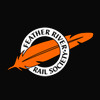
In 1983, the Feather River Rail Society was formed with the goal of preserving the legacy of the Western Pacific Railroad. The Union Pacific graciously donated several pieces of equipment and granted use of the former WP locomotive facility in the City of Portola to the society. This 37-acre site includes a 16,000 square foot diesel shop in active use from 1954 until 1974 and 2-1/2 miles of track. This facility became home to what is now the Western Pacific Railroad Museum at Portola.
Our collection includes locomotives, rolling stock, an extensive gathering of corporate records, paperwork, artifacts and historic photos and films. Visitors to the Western Pacific Railroad Museum soon discover that this is a hands-on facility where they are encouraged to climb into the cabs of locomotives, sit in the engineer's seats and browse through the rolling stock on display. Visitors can get up close to our restoration projects in the working shop. There is an exhibit room and various railroad-related displays throughout the building.
The FRRS is a not-for-profit, 501(c)3 volunteer organization that does not receive any government funding. The continued existence of this museum and archives depends upon revenue gathered from memberships, donations, fundraising, admissions and store sales. Please help support our mission to preserve and protect the legacy of the Western Pacific and its people. You are invited to become a member of the FRRS and join our team of volunteers here at the museum.
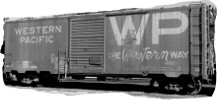
A boxcar is defined as a fully enclosed, rectangular freight car for carrying items requiring protection from the weather. Most boxcars range in size from 40 feet up to 89 feet, however, the most common size in the steam era was 40 feet and 50 feet after the coming of the diesel.
The Western Pacific Railroad Museum features a very large and diverse collection of boxcars that would be found on the average WP freight train.
While boxcars were the most prominent type of freight car seen until recently, intermodal transport has taken over as the most popular.
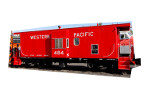
For more than a century, the caboose was a familiar sight at the end of almost every American freight train. The caboose served several purposes. It was the conductor's office where the conductor would work on the train's paperwork. It often served as the conductor's home away from home. The rear end brakeman would ride the caboose and help the conductor. They would watch the train for shifting loads, in-route damage and the infamous hotbox when friction bearings would fail and could start fires.
The Western Pacific Railroad Museum at Portola has an extensive collection of various styles of cabooses used on the WP and other western roads.
We run a demonstration caboose train on summer weekends and other special events that you can ride and see for yourself what the world looked like from the rear of a freight train.

Flatcars are rail cars that have an open, flat deck to carry a variety of loads. Examples of typical loads include large pieces of large machinery, rail, large pipe, road trailers
Designs come in a variety of lengths, tonnage and capacities for specialized commodities that are not subject to damage from the weather.
The museum has a variety of modern and historic flatcars. Some were used in maintenance-of-way service. Some were used commercially.

A Gondola is defined as an open top freight car used for carrying commodities not requiring protection from the weather. They load and unload from the top, and carry items such as pipe, steel, poles, woodchips, sugar beets, and machinery, to name a few. Some even have ends that drop down to facilitate loading and unloading.
The Western Pacific Railroad Museum features several gondolas of various vintages and lengths, including WP 6424, one of the first freight cars to feature "Roller Bearing" wheel sets, which are now the industry wide standard and a requirement of modern day railroads.
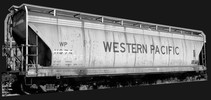
A hopper car is defined as a freight car, usually open at the top and containing one or more compartments so that bulk cargo can be quickly discharged through its bottom. Some hoppers are open topped for cargo not requiring protection from the weather, such as gravel, ballast or coal. Some hoppers are covered, usually with a roof, for cargo requiring protection from the weather, such as grain, corn, animal feed, sand, cereal, soda ash, powdered chemicals, etc.
The Western Pacific Railroad Museum has in its collection many different types of hopper cars of various sizes and types used for carrying all sorts of commodities on the Western Pacific Railroad. In addition, we also feature various hoppers used in Maintenance-of-Way Service, listed in the Maintenance-of-Way collection.
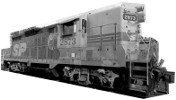
The Western Pacific Railroad Museum at Portola is home to one of the largest fleets of preserved, historic diesel locomotives in North America. Locomotives ranging in size from a 44 ton switching locomotive to the 270 ton UP 6946 Centennial, the largest diesel locomotive ever built.
We also have the WP 165, a 0-6-0 oil fired steam locomotive, built in built 1919. It has been a major restoration project for the society to bring her back to life.

Maintenance is an important and ongoing task for any railroad. The WPRM carries out various maintenance tasks around the museum using many pieces of our vintage collection, some built specifically for the purpose of maintaining the right-of-way.
A lot of the equipment at the museum was available for preservation because the railroads repurposed older equipment making them available for preservation later on.
The Western Pacific Railroad Museum features maintenance equipment of various sizes and vintages, from small speeder cars to a 250-ton capacity wrecking crane that we use from time to time.
We even have the working rotary snowplow used to rescue the stranded "City of San Francisco" in 1952!
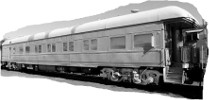
The Western Pacific Railroad Museum in Portola has a very diverse collection of passenger cars from various eras ranging throughout the history of the Feather River Route. Ornate executive business cars, baggage cars, mail cars, sleepers and coaches all share track space together in Portola, in varying states of restoration and preservation, taking our visitors back to a more romantic era of travel.
No less than four examples of the famed Streamliner, the "California Zephyr", are preserved in Portola, telling the story of the "Most talked about train in America", including the last remaining dining car from the CZ, our "Silver Plate", and Western Pacific locomotive #805-A, the last of WP's Passenger diesels. Welcome aboard!
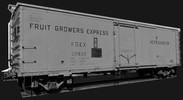
A Refrigerator Car (also known as a "Reefer") is defined as a fully enclosed freight car used for carrying perishable commodities requiring it to keep the commodities a constant temperature (usually cold or frozen) during transport.
The Western Pacific Railroad Museum features one of the most complete collections of refrigerator cars of any museum in the country. WPRM's reefer collection includes cars spanning the entire evolution of refrigerated rail transport, from cars among the first wooden reefers using large blocks of ice to cool the load, to a very early example of diesel powered mechanical refrigerator units, to modern cryogenic reefers utilizing carbon dioxide to keep the load cool.
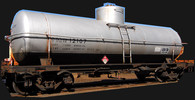
Tank cars are used to transport a variety of liquids and gases. Some tank cars are lined with special materials. Food-service tank cars may be lined with stainless steel, glass, or plastic. Cars for chemical transport may be lined with steel, rubber or other special materials that do not react with the chemicals the car carries.
Tank cars can be pressurized or non-pressurized, some are insulated and some have multiple compartments so they can carry more than one kind of material.
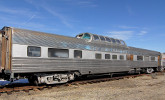
CB&Q 4717 – California Zephyr Vista Dome Coach
This car, named the “Silver Lodge” was built by the Budd Company in April 1948.
The Vista-Dome chair car, also called a dome coach, was the hallmark and most prominent feature of the California Zephyr. Each car featured forty-six reserved seats on the main level and an additional twenty-four unreserved seats in the dome level. Unlike many other trains, the dome seating in the forward cars was open to everyone and would remain so for the entire life of the CZ. Typically, three dome coaches were placed in each train and located directly behind the baggage car or, in later years, a flat top coach.
It was purchased by the FRRS, part of our " Zephyr Project". It is currently stored pending restoration.
The original California Zephyr ran over the Chicago, Burlington and Quincy Railroad from Chicago to Denver; the Denver and Rio Grande Western Railroad between Denver and Salt Lake City and the Western Pacific Railroad from Salt Lake City to Oakland. Cars owned by different railroads ran together in the train.
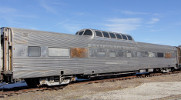
CB&Q 4720 – California Zephyr Vista Dome Coach
This car, named the “Silver Rifle” was built by the Budd Company in April 1948.
The Vista-Dome chair car, also called a dome coach, was the hallmark and most prominent feature of the California Zephyr. Each car featured forty-six reserved seats on the main level and an additional twenty-four unreserved seats in the dome level. Unlike many other trains, the dome seating in the forward cars was open to everyone and would remain so for the entire life of the CZ. Typically, three dome coaches were placed in each train and located directly behind the baggage car or, in later years, a flat top coach.
This car is on long term loan from the Golden Gate Railroad Museum.
The original California Zephyr ran over the Chicago, Burlington and Quincy Railroad from Chicago to Denver; the Denver and Rio Grande Western Railroad between Denver and Salt Lake City and the Western Pacific Railroad from Salt Lake City to Oakland. Cars owned by different railroads ran together in the train.
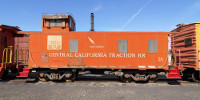
| Builder | American Car & Foundry |
| Built | 1927 |
| Type | Radial Roof Steel Cupola |
| Original cost | $4,500 |
| Operating weight | 49,500 lbs |
| Acquisition | Donated from CCT |
The CCT 24 was originally built for the Santa Fe Railway as part of its first order of all steel cabooses.
The Central California Traction Company was an electric interurban railroad built between Stockton and Sacramento in the early 20th century. In 1924, the railroad was purchase equally by the Western Pacific, Southern Pacific and Santa Fe railroads.
This caboose served for 40 years before being sold to the CCT in 1967.
CCT 24 was the last caboose in regular service on the railroad. It operated on the last train from Sacramento to Lodi when the line was embargoed in August 1998. Retired after 72 years of continuous service, this classic caboose sat in the railroad’s Stockton Shops until a trade was arranged that brought the 24 to the museum.
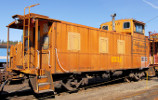
Rio Grande caboose No. 01414, built May 1941. It was built by D&RGW in their own Burnham shop in Denver.
This caboose is owned by Bill Parker who is letting us use it here at the museum. Since WP and Rio Grande were closely related from Day One, it was felt this caboose would represent that affiliation.
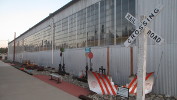
Diesel Shop
The Western Pacific was an early-adopter of diesel-electric technology compared to other Class-1 roads. At the beginning of 1939, the WP roster was comprised of 167 steam locomotives, of which 139 were oil burners. The first diesel to arrive on the WP showed up in September of that year.
The efficiencies of the diesel locomotive, coupled with a steady growth in traffic on the WP, resulted in more orders for new diesel locomotives from multiple manufacturers. The ascension of diesel power on the Western Pacific was so rapid that by 1952, steam engines were gone from Portola, and completely gone from the WP the following year. The old Portola roundhouse was now obsolete.
To service the diesels a new shop building and facility were constructed in 1954. The diesel shop was 225 feet long by 50 feet wide with a 25-foot lean-to on the north side. Two tracks went completely through the building and the south track was built with a full-length inspection pit. The building's length was chosen so that a four-unit diesel locomotive could be serviced in the building.
To make way for the new shop, the roundhouse was demolished, and after the new shop was completed, the turntable was removed and the track layout in the shop area was completely changed.
Elsewhere around the facility, the repair-in-place (RIP) track area remained on the west end of the shop, although the original jib crane and wheel storage area was moved closer to the west end of the building, where it remains today. Much of the original infrastructure for servicing the steam fleet, such as the water and oil tanks, the original stores building and various sheds and shanties were removed. In their place sprouted up diesel fuel storage tanks and columns, sanding towers, lube oil tanks, fuel, steam and lube oil risers, and such.
Around 1970 the shop was closed when the servicing of locomotives was centralized at the new diesel repair shop in Stockton.
In l984 the facility was handed over to the fledgling Feather River Rail Society to develop what was then called the Portola Railroad Museum.
Today, the facility has evolved into the Western Pacific Railroad Museum at Portola. The original Western Pacific diesel shop is the centerpiece of the museum and the 37-acre facility.
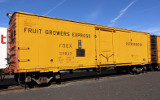
FGEX 55932
FGEX 55932 is a 40 foot steel ice refrigerator car built in December 1927. It was rebuilt in 1950. It was owned by Fruit Growers Express and eventually donated to the museum by Albers Feed Company in Reno.
Fruit Growers Express (FGE) was a railroad refrigerator car leasing company that began as a produce-hauling subsidiary of Armour and Company's private refrigerator car line. Its customers complained they were overcharged and in 1919 the Federal Trade Commission ordered the company's sale for anti-trust reasons.
Incorporated on March 18, 1920 the firm took possession of 4,280 pieces of rolling stock, repairs shops at Alexandria, Virginia and Jacksonville, Florida, and numerous ice plants and other facilities scattered throughout the East Coast on May 1. By year's end, the Chicago and Eastern Illinois, New Haven, and Norfolk and Western railroads became major stockholders.
In order to compete with the Pacific Fruit Express and Santa Fe Refrigerator Despatch in the west, FGE and the Great Northern Railway formed the Western Fruit Express (WFE) on July 18, 1923, a move that added 3,000 cars to the equipment pool. By 1926, FGE had expanded its service into the Pacific Northwest and the Midwest through the WFE and the Burlington Refrigerator Express (BREX), its other partly owned subsidiary.[1]
Fruit Growers Express is now controlled by the CSX Corporation.
[1] wikipedia.org (2005). WIKIPEDIA. In Fruit Growers Express. Retrieved April 27, 2018, from https://en.wikipedia.org/wiki/Fruit_Growers_Express
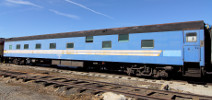
FRRX 1112 "Edenwold"
We use it as sleeping quarters for WPRM volunteers. It was built in 1954 by the Pullman Standard Company as a 4-8-4 Sleeper for the Canadian National. All cars in this series were named after Canadian cities and towns whose names began with an “E”.
In 1977, the Canadian government, following the lead of the United States’ formation of Amtrak in 1971, created VIA Rail combining the passenger rail services of Canadian National and Canadian Pacific. This car was then used in VIA service.
Eventually it was purchased and donated to the FRRS by member Jack Hathaway.
It is not open for public display.
The 4-8-4 sleeper has four bedrooms (A-D) that sleep two people each, eight roomettes (5-12) that accommodate one person each and four open sections (1-4.) In the open section of the car we usually only have the lower berths opened for use.
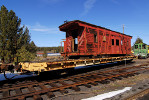
FRRX 1851
FRRX 1851 is a typical 60 foot steel flatcar. It was built in June 1965 and rebuilt in March 1981. Before coming to the museum it was part of the Trailer Train Company as HTTX 1851.
TTX Company (formerly Trailer Train) is a provider of railcars and related freight car management services to the North American rail industry. TTX's pool of railcars – over 220,000 cars and intermodal wells – supports shippers in the intermodal, automotive, paper & forest, metals, machinery, wind energy and other markets where flatcars, boxcars and gondolas are required. Owned by a number of large North American railroads, TTX’s pools allow members to share capacity to reduce costs and risk.
TTX was founded in 1955 by the Pennsylvania Railroad and the Norfolk and Western Railway, and Rail-Trailer Corporation. Pennsylvania Railroad employees - 6,000 in total - entered possible names in a drawing for the new company, and the name "Trailer Train" won. Trailer Train's original goals were to standardize Trailer On Flat Car (TOFC) railcar practices, foster the growth of transportation, provide its members with the best available equipment at the lowest cost and keep its members abreast of new developments. In 1991, the company changed its company name from Trailer Train to TTX.[1]
[1] wikipedia.org (2018). WIKIPEDIA. In TTX Company. Retrieved April 30, 2018, from https://en.wikipedia.org/wiki/TTX_Company
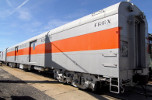
FRRX 5653 - Baggage Car
The FRRX 5653 baggage car is the former UP 5653 lightweight baggage car. It was built in 1954 by American Car & Foundry. It is 85 feet long and is equipped with six-wheel disc brake trucks.
"It was equipped with a lavatory, hopper, water cooler, desk, and wardrobe for a riding crew member. Thus, the car received a red star under the Railway Express Agency lettering denoting that it was equipped for messenger service." [1]
We use this car in our annual Pumpkin Express trains in October and during our Santa Trains in December. It has also been used when we have visited other events "outside the gate" as a mobile museum store.
It was repainted by the FRRS in 2001. Union Pacific donated it to the WPRM in 1992.
[1] Model 160 N Scale Website. (2010) Retrieved March 16, 2017 from http://www.model160.com/n-scale-resources/prototypes-of-n-scale-models/acf-plan-7679560-lot-3810-4094-up-baggage-car
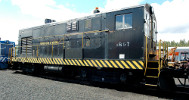
| Builder | Fairbanks, Morse & Co. |
| Built | January 1953 |
| Type | H12-44 |
| Horsepower | 1200 |
| Serial number | 12L681 |
| Original cost | $224,700 |
| Top speed | Max speed is 40-45 mph (It has 14:68 gearing, which is good for 60 mph, but the trucks it's on are only good for 40-45 mph.) |
| Operating weight | 246,000 lbs |
| Acquisition | Purchased by FRRS |
United States Army 1857 – Diesel Electric Switching Locomotive
This locomotive was build by the firm of Fairbanks, Morse and Company in Beloit, Wisconsin. F-M was a relative latecomer to the diesel locomotive industry, but tried to break in with an unusual and innovative prime mover design using opposed piston engines. While ultimately unsuccessful in locomotive applications, F-M's prime movers remain in production today and are used for naval vessels and power generators.
Between May 1950 and March 1961, 336 of this model were built, WP neighbors Southern Pacific and Denver & Rio Grande Western both rostered them. However, F-M could not compete with the larger builders. It sold its last domestic locomotive in 1958 and its last locomotive ever left the factory in 1963. Today, only a handful of running F-M locomotives remain, predominantly in museums.
It is currently displayed as Feather River & Western, a fictitious railroad.
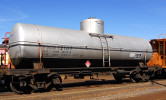
FRW 12107
This tank car was originally built in April 1952 by the American Car Foundry for the United States Army. It is a 10,000 gallon welded tank car intended for domestic service. It was originally lettered USAX 12107, then renumbered to DODX 12107.
It was purchased by the Feather River Rail Society and converted into our locomotive fuel storage in 1992. We changed the reporting marks to the fictitious Feather River and Western railroad here at the museum.
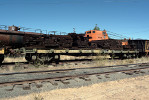
FRW 15545
Feather River Western 15545 is a 40 foot steel/wood flatcar. It was built for the U.S. Military as USAX 15545, later it was renumbered as DODX 15545. It was purchased through the government surplus property program by the FRRS in October 1990.
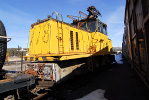
| Builder | General Electric Company |
| Built | April 1958 |
| Type | 125 ton |
| Horsepower | 900 |
| Supply voltage | 750 volts direct current |
| Serial number | 33348 |
| Operating weight | 250,000 lbs |
| Acquisition | Donated from Kennecott Copper Company |
The Kennecott Copper Company was a leader in using electric locomotives in its operations, beginning in 1927. The locomotives used by KCC were typically of a design referred to as "steeplecabs", with a raised operator's cab centered between two equipment hoods. This style was very common on electric railroads and most were built by General Electric. In 1958, the Santa Rita Mine in New Mexico took delivery of two large steeplecab locomotives, which were probably the last of this type ever built in North America.
Numbered as Chino Mines 4, this engine was the last electric locomotive delivered to Kennecott. In December 1971, it was moved to Bingham Canyon for use on trains in the huge pit and renumbered as 778. In 1976, it was repainted in red, white and blue colors to celebrate the American Bicentennial.
Retired in November 1983 with the close of KCC electric railroad operations, this historic unit was donated to represent the mining industry that sustained the east end of the Western Pacific.
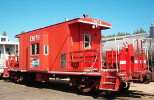
| Builder | Missouri Pacific Railroad at their Sedalia and DeSoto, MO Shops |
| Built | December 1980 |
| Type | Short body road caboose |
| Length | 39 feet 1 inch |
| Operating weight | 51,900 lbs |
| Acquisition | Donated by Union Pacific |
This short-bodied caboose was the result of extensive research and development by the Missouri Pacific Railroad in the late 1970s. The use model for cabooses had been changing and the MP wanted to modernize their fleet.
The MP built 350 of these cabooses in their own shops until 1981, the last such cars acquired by the railroad.
The 13878 served on the Missouri Pacific for a little over two years before the "MoP" was purchased by the Union Pacific Railroad in the same merger which brought the Western Pacific into the UP. The 13878 was retied on January 25, 1990, still wearing MP colors.
A prominent feature of this design is the bay windows on the body. Instead of riding on top of the car in a cupola, crewmembers sat in the extended bays to watch the train for defects and problems.
By the 1980s, technology allowed remote sensing of many aspects of the train ending the last duties of the rear end crew. The entire train crew began riding in the locomotive cabs and the cabooses, with only a few exceptions, were retired.
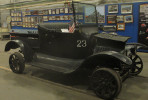
You can watch a 7 minute video about the return to service in June 2018 of M23: M23 Rides Again!.
(after the video starts you may wish to use the YouTube "Full-screen" option to enlarge the video if you are using a mobile device.)
| Builder | Ford |
| Built | 1923 |
| Type | Model-T Roadster |
| Acquisition | Donated |
Model T Ford Motorcar 23 is a representative example of the typical light transportation vehicles used on logging railroads. They were used to take staples or "the boss" to the logging camps and for track inspection. The Sierra Railroad used a similar car, which they still have.
Our car is built from a 1923 roadster. The trunk has been removed and replaced with an era wooden pick-up bed. The front and rear axles have been adapted with Fairmont 20" wheels.
WPRM acquired Motorcar 23 by donation in 1996.
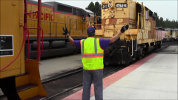
You can watch a short video about the hand signals our Operating Department uses to operation our railroad. (after the video starts you may wish to use the YouTube "Full-screen" option to enlarge the video if you are using a mobile device.)
Would YOU like to work on the Railroad?
Join our Operating Department!
The Western Pacific Railroad Museum at Portola operates trains every weekend between Memorial Day and Labor Day. We also run our Pumpkin Express in October, Santa Trains in December and special event trains. If you have always wanted to have a taste of "working on the railroad", such as connecting air hoses, giving hand signals to the engineer and pulling pins on couplers, then this is your opportunity.
FRRS members (active and above) who would like to participate in the museum's train operating crews are required first to take a rules examination, sign a liability release and then to be instructed in safe operating procedures. If you are not a member, you may join at training.
There is information on the society website wplives.org, or talk with one of us while you are at the museum! We always welcome new members to join us to help preserve the spirit of the Willing People of the Western Pacific Railroad.
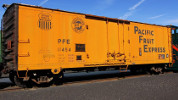
PFE 11454
PFE 11454 is a 40 foot steel ice reefer built in May 1957. It is a class R-40-27 and was among the last ice reefers built. It was part of Pacific Fruit Express.
Pacific Fruit Express (PFE) was founded on December 7, 1906 as a joint venture between the Union Pacific and Southern Pacific railroads. It began operation on October 1, 1907, with a fleet of 6,600 refrigerator cars built by the American Car and Foundry Company.
In 1923, the Western Pacific Railroad joined the venture by leasing its own new fleet of 2,775 reefers to PFE. They were painted in standard PFE colors with only WP heralds on the cars instead of the paired UP-SP markings. The WP cars were all retired by the late 1950s, among the last wooden reefers in PFE's fleet. WP ended its partnership with PFE in late 1967 and joined Fruit Growers Express instead.
PFE's assets were divided between the UP and SP when the company was split on April 1, 1978. It is now a UP subsidiary. [1]
[1] wikipedia.org (2018). WIKIPEDIA. In Pacific Fruit Express. Retrieved April 28, 2018, from https://en.wikipedia.org/wiki/Pacific_Fruit_Express
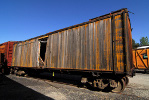
View a mechanical drawing of PFE 52138.
PFE 52138
Pacific Fruit Express 52138 was built in 1924 by American Car and Foundry for the Western Pacific. It is a 40 foot wood bodied refrigerator car. When built, this car had a steel underframe, wood superstructure, metal roof, and wood sides and ends. This style of refrigerator car used ice placed into bunkers on the ends of the car for cooling, as opposed to mechanical refrigeration systems.
In 1923, WP ordered 2000, 40 foot wood refrigerator cars from American Car and Foundry. They were to be lettered WESTERN REFRIGERATOR LINE as part of a plan by the WP to complete with Pacific Fruit Express, a refrigerator car supplier owned by the Southern Pacific and Union Pacific Railroads. AC&F built 146 of these cars before WP entered into a pool agreement with PFE to add the WP cars to PFE’s large fleet. The original 2000 cars were joined by 775 more in 1924, which included 52138. The cars entered service with PFE reporting marks and number series, WP emblems and painted yellow sides with boxcar red ends and roof.
Starting in 1938, PFE began reconditioning the WP cars. As WP wanted to minimize cost on this work, it was not as extensive as the reconditioning done to PFE’s own cars. The WP cars received rebuilt wood bodies, repairs to their metal roofs and new paint. WP declined to have steel superstructures added to the bodies.
Scrapping of older cars began accelerating after 1947, with only 914 WP cars in service by 1950. It appears that WP / PFE 52138 was retired around this time and was not part of the later rebuilding program, thus being a rare survivor without a steel superstructure and added cooling fans.
Pacific Fruit Express planned to rebuild the best WP cars at their Roseville Shops and renumber them into series 55001-55900 starting in 1952. WP requested a minimum cost rebuild so PFE budgeted $10 million for the project. Steel frame superstructures, completely rebuilt wood bodies, electric air-circulating fans, and other modern features were added.
By the mid sixties, mass retirements of wooden cars were made and WP’s PFE cars were retired. PFE supplied ice and mechanical reefer cars to WP even through there were no WP cars in the fleet. In 1967, Fruit Growers Express made the Western Pacific a nice offer to join their fleet. This ended WP’s involvement with PFE.
The car was donated by John Ryczkowski to the museum.
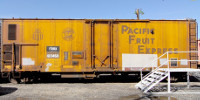
A class R-30-40 car, PFE 100468 is among the earliest mechanical reefers built. Pacific Fruit Express, the nation's largest owner of refrigerator cars, ordered its first mechanical reefer car in 1953 and by the end of the year some 380 55' cars were in service.
To meet the needs of smaller shippers, 500 45' long 40-ton cars were ordered. These cars, the R-40-30 class, pioneered an "all-purpose" refrigeration system that handled a wider range of temperatures than the first cars, suitable for everything from fresh produce to frozen foods.
This car was donated by the California State Railroad Museum.
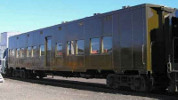
| Builder | Pullman Company |
| Built | June 1943 |
| Type | Troop Sleeper |
| Length | 51 feet 8 inches |
| Height | 13 feet 2 inches |
| Capacity | 30 persons (29 troops / 1 porter) |
| Operating weight | 70,700 lbs |
| Acquisition | Donated by Norm Holmes |
During World War II, mobilization of fighting troops by rail resulted in huge increases in traffic. Passenger miles would quadruple during 1940-1944.
The basic challenge was made worse by a lack of equipment and a War Production Board that would not allow the building of new passenger cars. A solution was found when the Pullman Company constructed a total of 2,400 troop sleepers between 1943-1945.
Pullman 8300 was the first car of the second order built by Pullman. Equipped with 30 bunks set in ten banks three high, the car was designed to be comfortable, but basic and thus easy to build.
The middle and lower bunks converted to daytime seating and each car included four washbasins and two restrooms. Each bunk set included a weapons rack and a place for footlockers.
Car 8300 went to the Alaska Railroad after the war, where it was used as a maintenance-of-way bunk car. After MofW use, it was being used as a bunkhouse for a youth camp in Alaska when Norm purchased it. Never substantially altered, the 8300 is a fine representative of a unique care type that provided crucial military service on many railroads, including the Western Pacific, during the war.
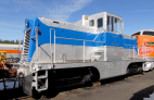
| Builder | ALCo General Electric |
| Built | August 1945 |
| Type | 44 Ton |
| Horsepower | 190 hp per engine for a total of 380 hp |
| Serial number | 27819 |
| Top speed | 35 MPH |
| Operating weight | 88,000 lbs (44 tons) |
| Acquisition | Donated by the QRR's owner, Sierra Pacific Industries |
Quincy 3 was the first diesel locomotive used by the Quincy Railroad that connected with the Western Pacific just east of Keddie. The Quincy was built in response to the WP bypassing the town of Quincy when the mainline was built. Quincy is the seat of Plumas County and was the home of Arthur Keddie, the man who first surveyed the route of the WP and advocated its construction.
The 3, an ALCo/GE 44 ton locomotive, was built in August 1945 served as the main motive power until an Alco S-1 locomotive, Q 4 ex-WP 504, arrived in 1973.
It was eventually retired and donated by the Quincy Railroad’s owner, Sierra Pacific Industries, to the museum.
This engine has never been out of Plumas County since it was delivered to the Quincy.
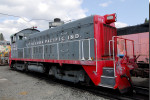
You can OPERATE this locomotive...see our Run-A-Locomotive program to learn how!
| Builder | Electro-Motive Division of General Motors |
| Built | October 1950 |
| Type | TR6 |
| Horsepower | 800 |
| Serial number | 13550 |
| Operating weight | 230,000 lbs |
| Acquisition | Donated by Sierra Pacific Industries |
The Quincy 1100 is an EMD TR6 switching locomotive built in 1951 as a demonstrator and sold to Southern Pacific.
While working the NWP in Eureka between 1951 and 1953 it was given the name, “Little Lulu” after a comic strip character, a name it retains today.
In 1985, Southern Pacific wanted to abandon the 23-mile branch from Wendel to Susanville. This would leave the Sierra Pacific Industries mill at Susanville without rail service.
A deal was struck where SPI would lease and operate the branch as an extension of its Quincy Railroad.
1100 was purchased by SPI for $14,000 and served the mill.
Sierra Pacific Industries closed their Susanville mill in 2004. The last use of No. 1100 was on April 29, 2004.After the last of the milled lumber was shipped out on June 24, 2004 the 1100 was out of a job.
SPI donated the 1100 to the FRRS and she came to the museum in December 2004.
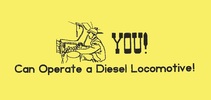
You can watch a short video about the Run-A-Locomotive program at our museum.
(after the video starts you may wish to use the YouTube "Full-screen" option to enlarge the video if you are using a mobile device.)
Our World Famous "Run-A-Locomotive" program allows you, our museum visitor, to rent a vintage diesel locomotive and operate it on the museum grounds, under the close supervision of your own private instructor. Relive a childhood fantasy! No experience required, just an adventurous mind. Income from locomotive rentals helps fund the museum and restoration of our historic equipment.
There is information about how YOU can operate a diesel locomotive on the society website, wplives.org, or speak with one of us in the Museum Store while you are at the museum!
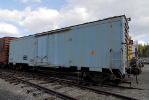
SFRD 8199
Santa Fe Reefer Despatch 8199 is a 40 foot steel ice refrigerator car. It was originally built as a wood body reefer in the 1920’s and then rebuild as a class Rr-40 steel ice reefer in 1946. While in service the car wore the Santa Fe map paint scheme.
The Santa Fe Refrigerator Despatch (reporting mark SFRD) was a railroad refrigerator car line established as a subsidiary of the Atchison, Topeka and Santa Fe Railway in 1884 to carry perishable commodities. Though the line started out with a mere 25 ventilated fruit cars and 8 ice-cooled refrigerator cars, by 1910 its roster had swollen to 6,055 total units (compared to the 8,100 units its largest competitor, the Pacific Fruit Express).
As of 1929 the line was carrying some 43 percent of California's citrus crop, most of which travelled aboard its "Green Fruit Express" refrigerator car special. Some 100,000 produce loads were shipped from the fields of Arizona and California to East Coast markets each growing season. [1]
[1] wikipedia.org (2017). WIKIPEDIA. In Santa Fe Refrigerator Despatch. Retrieved April 29, 2018, from https://en.wikipedia.org/wiki/Santa_Fe_Refrigerator_Despatch
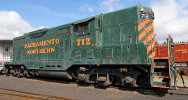
| Builder | Electro-Motive Division of General Motors |
| Built | April 1953 |
| Type | GP-7 |
| Horsepower | 1500 |
| Serial number | 18168 |
| Original cost | $170,833 |
| Top speed | 65 MPH |
| Operating weight | 246,800 lbs |
| Acquisition | Donated by Bay Area Electric Railway Association |
The Sacramento Northern was a subsidiary railroad of the Western Pacific. The SN was originally an electric interurban railroad from Oakland to Chico, but by the late 1960s it was dieselized.
SN 712 was built for the Western Pacific as part of WP’s second order for this locomotive model. In July 1971, the 712 was transferred to the SN.
The SN 712 was among the first on the WP system to be repainted from the as delivered silver and orange colors into the new "Perlman Green" paint, adopted with the appointment of Alfred E. Perlman to the Presidency of the WP in December 1970.
The 712 was the last SN lettered locomotive in service. Upon retirement by Union Pacific in March 1985, the engine was donated to the Western Railway Museum near Fairfield California, where it was repainted and displayed. In 2005, the Feather River Rail Society and Western Railway Museum, operated by the Bay Area Electric Railway Association, traded several pieces of equipment, including SN 712, to better focus on their respective collections.
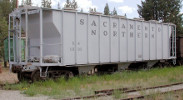
Sacramento Northern 5005 AC&F 3 Bay Covered Hopper
The first batch of SN covered hoppers, numbered 5001-5010, were delivered by American Car & Foundry in February 1958. These were monster cars for their time, with a 47-foot length and a 3200-cubic foot volume. A similar block of Pullman Standard PS-2 cars soon followed in May 1959, numbered 5011-5020 at 3219 cubic feet. Finally, in March 1960, AC&F supplied 5101-5110 at 3500 cubic feet. The latter two groups were equipped with roller bearing trucks, which were also used on most subsequent SN cars.
These hoppers were likely used in rice service, especially from Conaway Farms near Woodland, but may also have been used to ship bulk walnuts from Walnut Creek to Stockton during the harvest season. More often they were found in WP service.
SN 5005 is from the first group of covered hoppers owned by the SN. Western Pacific itself had only acquired its first covered hoppers in 1956 and had received its first 3-bay hoppers just a few months before.
The SN eventually rostered 40 covered hoppers, both flat side, like the 5005, and cylindrical body. This car is the only known survivor of the SN's fleet.
It was donated by Union Pacific to the museum.
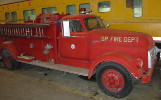
| Builder | GMC |
| Built | 1952 |
| Type | Model 624 Pumper |
| Horsepower | 140 @ 3000 RPM |
| Serial number | 624 36 129 |
| Pump | John Bean Royal 55 |
| Mileage | 74,500 |
| Maximum Gross weight | 22,000 lbs |
| Maximum Combination Gross weight | 48,000 lbs |
| Acquisition | Donated by Jim Dobbas |
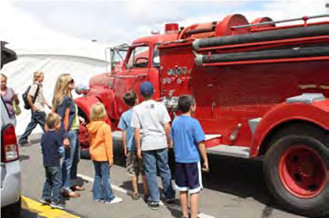
Our former Southern Pacific fire truck made its Hot August Nights debut in 2009.
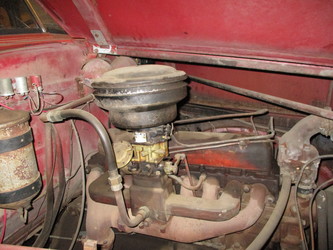
Fire truck engine
SP Fire Truck 1
The SP 1 Fire Truck is a 1952 GMC; it was bought new by the Southern Pacific and spent most of its life in the Sacramento Shops. It was the facility fire truck until the shops were closed in 1999. The truck wound up being owned by Jim Dobbas, and was stored for quite a while in the Erecting Shop in Sacramento.
Jim Dobbas then moved it to his property outside of Colfax. FRRS member Rod McClure arranged the donation of the truck to the FRRS from Jim Dobbas, with the condition that we keep it inside, protected from the weather, as much as possible. When the FRRS went to obtain insurance on it, we had a bit of difficulty, since it was never registered by the SP while it was in the shops.
Since coming to Portola, we have displayed it at the museum and taken it to a few special events. It was a hit at the 2009 Hot August nights show in Reno and drove around the parking lot wailing its siren!
The truck is mostly operational, but needs some engine work, new tires and rims.
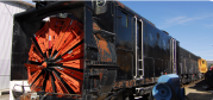
You can watch a short video about the history of the rotary snowplow: Sacramento abc10 snowplow video.
(after the video starts you may wish to use the YouTube "Full-screen" option to enlarge the video if you are using a mobile device.)
| Builder | American Locomotive Co. - Brooks Works |
| Built | September 1927 |
| Type | Leslie Patent Rotary Snowplow |
| Serial number | 67429 |
| Original cost | $16,641 |
| Operating weight | 263,800 lbs |
| Acquisition | Donated by Union Pacific |
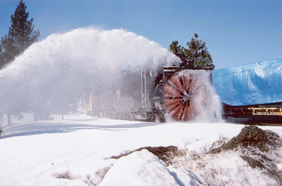
The American Locomotive Company built SPMW 208 as a steam powered rotary snowplow in 1927 for the Southern Pacific.
Starting in the 1950’s, Southern Pacific began converting its steam-powered rotaries to electrically powered units by installing a large electric motor in the carbody and providing power using an old streamlined style freight locomotive that was permanently assigned to each plow. This power unit was known as a “snail”. Unable to move itself, each plow/snail combination would be pushed by several locomotives to clear deep snow from the tracks.
SPMW 208 was the last steam unit converted to diesel in 1970.
SPMW 208 (numbered 7208 at the time) was one of the rotary snowplows involved in the rescue of the trapped City of San Francisco passenger train in January 1952.
It was leased by the WP in February 1973 for use on the High Line out of Keddie, and was returned to SP shortly thereafter. It was the last rotary to work on the Western Pacific Railroad.
The plow is fully operational here at the museum.
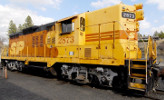
You can OPERATE this locomotive...see our Run-A-Locomotive program to learn how!
SP 2873 was the first high nose SP locomotive painted in the Kodachrome paint scheme.
| Builder | Electro-Motive Division of General Motors |
| Built | December 1956 |
| Type | GP9 |
| Horsepower | 1750 |
| Serial number | 22897 |
| Top speed | 65 MPH |
| Operating weight | 247,600 lbs |
| Acquisition | Purchased by FRRS |
While the Western Pacific rostered a relatively small fleet of GP9's at eight units, neighboring road Southern Pacific rostered 340 of the rugged road switcher. SP 2873 was originally built in December 1956 as SP Subsidiary Texas & New Orleans 443.
In December 1983, both Southern Pacific and the Santa Fe railroad attempted a merger, creating the Santa Fe Southern Pacific Corporation as a holding company to manage the newly combined railroad. However, in July 1986, the Interstate Commerce Commission denied this merger due to opposition by the US Department of Justice. In June 1987, the ICC denied the appeal by the SFSP, thus ending merger proceedings.
SP 2873 came to the Western Pacific Railroad Museum in 1992 after members found it in a scrap yard in Richmond, California. The FRRS purchased the locomotive and today the engine is used frequently at the WPRM as a yard switcher, in Caboose Train Service, and is a popular locomotive in the museum's Run-A-Locomotive program where our visitors are invited to operate the 2873 under the guidance of a qualified instructor.
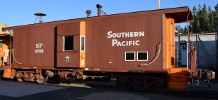
| Builder | International Car Co. Kenton, OH |
| Built | March 1980 |
| Type | SP class C-50-9 |
| Acquisition | Acquired by FRRS in 2006 from UP |
Southern Pacific 4706 is a SP class C-50-9 caboose which was built in March 1980. She is known informally as "Christine" due to the graffiti image on one side when she came to the museum.
She was acquired by the FRRS in 2006 from Union Pacific (last used as an unoccupied shoving platform, with doors and windows welded up, at the ex-SP Newhall Yard in San Jose).
The FRRS completed a major restoration of the SP 4706 caboose in August 2016.
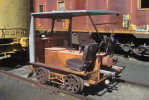
| Builder | Fairmont |
| Built | circa 1960 + |
| Type | MT-14L |
| Horsepower | 18 |
| Serial number | 234161 RR ID SPMW5594 |
| Top speed | |
| Operating weight | 1,052 lbs |
| Acquisition | Donated by Kerry Cochran 2012 |
WHAT IS THIS THING ? !
This is a Railroad Motorcar, or Speeder. Smaller models, like this one, were routinely used to inspect the many miles of track for defects. Larger versions would carry half a dozen workers and pull a few trailers loaded with spikes & tools, to handle track maintenance.
Use of speeders has been phased out over the past couple decades in favor of Hy-Rail Vehicles, which are standard road vehicles with retractable guide wheels that can operate on road or rail.
This particular example is a Fairmont MT-14L. It was used by Southern Pacific and was numbered SPMW 5594.
It was donated by Kerry Cochran to the museum in 2012.

SP 358646 Sugar Beet Gondola
SP 358646 is a composite wood gondola that was built in October 1949 and used in sugar beet service. The top extensions were added in the sixties to increase the car's capacity. This composite sugar beet gondola survived decades of reliable service before coming to the museum.
The car was donated to the museum by Imperial Sugar company in 1993.
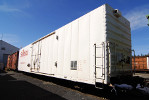
Simplot - JRSX 5021
The Simplot Company donated a Cyrogenic refrigerated rail car to our museum in 2002. The car used a patented CO2 refrigeration technology to transport frozen food products. The Simplot Company decided to phase out these cars and felt that one of these unique cars should be saved.
Since the company had donated an Alco RS32 locomotive to our museum, we were asked if we wanted one of the refrigerator cars. The car was built as an insulated boxcar for SSW in 1968 and converted to its present configuration in 1988.
The car is 60 feet long and in excellent condition. It is used for archival storage.
We wish to thank the Simplot Company and Ed Bryant, one of the inventors of the technology, for this generous donation and the Union Pacific for providing free transportation.
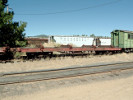
Read about how the museum got the TPL 411 and 580 log cars from Train Sheet #60 on page 4
TPL 411 & 580
The Pacific Lumber Company (TPL) had held onto the remains of their logging railroad for years after closing it in the late 1960’s. In 1992, they decided to dispose of the equipment. FRRS member Kent Stephens read about the decision and approached TPL about acquiring the cars. The FRRS purchased the two best cars of the remaining fleet for preservation at the museum.
TPL #411 and #580 are 44 foot log flatcars of all wood construction and were reconstructed in 1977 with all wood components renewed at that time; and they appear to never have been used afterwards. The only steel in the cars are the trucks, couplers, AB brake components, end sills, truss rods and four cross pieces of light rail on the wood deck that the logs rested on. The weight of the cars without their trucks is a low 16,000 pounds. The bar trucks weigh 6800 pounds each. These log cars are fairly typical of the cars used from the early 1900's for half a century into the 1950's by many west coast lumber companies.
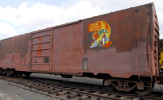
| Builder | Pullman-Standard |
| Builder Lot Number | 8240 |
| Built | July 1955 |
| Type | PS-1 XM Boxcar |
| Volume | 4844 cubic ft |
| Capacity | 50-tons |
| Operational Weight | 52,000 lbs |
| Interior Length | 50 ft 5-9⁄16 in |
| Interior Width | 9 ft 2-1⁄16 in |
| Interior Height | 10 ft 5-1⁄2 in |
| Length Over Strikers | 51 ft 10 in |
| Overall Width | 10 ft 5-1⁄16 in |
| Overall Height | 14 ft 11-15⁄16 in |
| Clear Door Opening | 8 ft 0 in wide X 9 ft 10-5⁄16 in high |
| Door Type | Superior 6-panel sliding |
| Trucks | Scullin A-3 Ride Control |
Tidewater Southern 520 - Boxcar
For most of its history, Tidewater Southern was a subsidiary of the Western Pacific Railroad.
The Tidewater's 501 series boxcars comprised 25 cars delivered in July of 1955. They were the first real fleet of interchange freight cars owned by the railroad.
The 501 series appear to have been a follow-on to a Western Pacific order delivered in June 1955. WP 36011, part of that order is part of the WPRM collection.
The most interesting aspect to the Tidewater cars was the unique logo they were delivered with. This special logo depicted a cornucopia, or "horn of plenty", with the slogan "Serving California's Heartland". This was one of the most colorful logos ever used in railroading and was only used on these 25 cars.
Before it was donated to the museum, Tidewater Southern 521 was reassigned to maintenance-of-way and renumbered WPMW 37-10. It is now at our museum hidden under silver paint and lettered as WPMW 37-10.
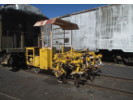
Tamper
This machine is a Jackson model 100 tamper, this is an early model produced in the late 1950s and is quite small by todayˈs standards. Tampers are used to vibrate the rock under the ties to raise and level the roadbed of the railroad. This is a vibratory electric tamper it has eight tamping heads to do both rails on both sides of the railroad tie. This machine required a crew of four to six people with rail jacks to proceed it raising and leveling the track. The tamper followed the crew tamping the raised roadbed and about a quarter mile could be done in a day.
Modern tampers use lights and lasers and have multiple rail clamps to raise and align track in a continuous motion with a single operator and can do a mile or more per day.

| Builder | Pullman Company |
| Built | March 1917 |
| Type | Streamline heavyweight business observation car |
| Length | 82 ft. 4 in. |
| Operating weight | 191,500 lbs. |
| Acquisition | Donated by Union Pacific |
Union Pacific Railroad 105 – Business Observation Car
This passenger car was built for Union Pacific Railroad by the Pullman Company in 1917 for use by UP's President as his own private railroad car. In that service, the care was number UP 100. The car functioned as an office and home-away-from-home for the President during business trips around the Union Pacific's system. When built, its appearance was like other heavyweight cars of the era, including opening sash windows and wooden interior details. It was similar to the Western Pacific business car 106, "Charles O Sweetwood", another Pullman heavyweight car in our collection.
In 1935, the car was completely rebuilt and air conditioning added. At that time, its appearance changed from its as built condition. In 1952, it became number 101 and, in 1957, number 102, each time changing assignments. In September 1965, the car was upgraded once again with new air conditioning and sealed windows, attaining the appearance it has today. The wooden interior panels were covered with Formica and the care was renumbered 105.
Throughout its many rebuildings and reassignments, the 105 remained an executive business car and never saw service as a "regular" passenger car. Inside you will find large bedrooms (for a railroad car), a dining room, a lounge with large windows facing the rear observation platform and a compact but very capable kitchen.
The car was retired and donated to the Feather River Rail Society by UP in 1986, a fine example of a later railroad business car.
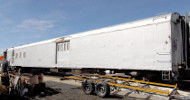
The UP 5810 is usually not open to the public, but you can scroll down this page and see some interior photos.
| Builder | Pullman-Standard |
| Built | January 1942 |
| Type | Floor Plan 7470 |
| Lot number | 6664 |
| Length | Over Buffers: 84'-10" |
| Acquisition | arranged by Steve Lee, then in charge of the UP Steam and Heritage Fleet programs. |
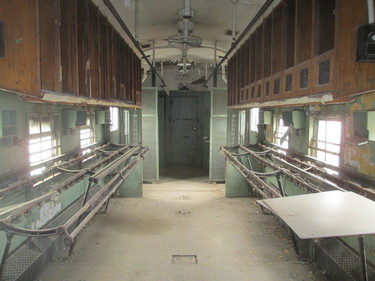
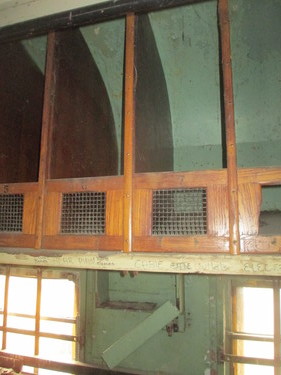
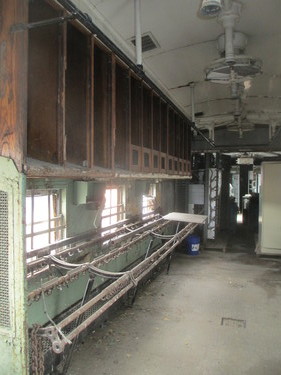
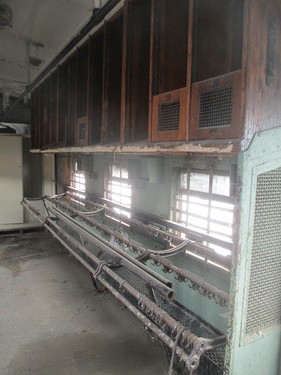
Photos by - Paul Finnegan 4/11/2016
UP 5810 - Railway Post Office Car
Shortly after W.W.II, there were 1,500 RPO routes crisscrossing the United States with more than 30,000 workers in more than 4,000 cars. The use of RPO cars declined during the 1960's, and by 1965, only 190 trains carried mail. In 1971, the Post Office terminated seven of the eight remaining routes.[1]
UP 5810 was built in January 1942, part of Pullman-Standard Lot #6664, Floor Plan 7470, it was the 10th car in the lot, which were numbered 5801-5810. All cars in this series were modified from Baggage-Postal to Postal-Storage and all were vacated from UP's passenger car roster in September of 1970 (going to Maintenance of Way service).[2]
UP 5810 was in a long string of maintenance-of-way equipment in Fremont in 2005. Acquisition for the museum was arranged by Steve Lee, then in charge of the UP Steam and Heritage Fleet programs.
[1] Rails West. (2010). In Railway Post Office Car. Retrieved April 18, 2018 from http://www.railswest.com/passengertrains.html
[2] UtahRails.net. (2018). In Union Pacific Numbered Passenger Cars, Part 7. Retrieved April 18, 2018 from http://utahrails.net/pass/pass-numbered-7.php
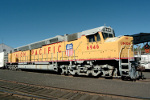
| Builder | Electro-Motive Division of General Motors |
| Built | September 1971 |
| Type | DDA40X |
| Horsepower | 6600 from two prime movers |
| Serial number | 35520 |
| Original cost | $551,168 |
| Top speed | 90 MPH |
| Operating weight | 545,432 lbs |
| Acquisition | Donated by Union Pacific |
UP6946 – Centennial
The Union Pacific was long famous for its large, powerful steam locomotives. In the diesel era, that tradition continued as UP tried to find the most powerful locomotives available. In 1969, the railroad began operating the largest and highest horsepower diesels ever built: the DDA40Xs.
A custom model for UP, these 270 ton, 98 foot 5 inch long monsters produced 6600 HP from two 16 cylinder diesel engines. They were capable of 90 MPH and averaged over 200,000 miles per year before 1980.
The DDA40Xs were called "Centennials" in honor of the 100th anniversary of the Golden Spike Ceremony, May 10, 1869, that completed the transcontinental railroad. In all, 47 units, numbered 6900-6946, were built from May, 1969 to September, 1971. The engines worked UP’s mainlines through the American Midwest reaching to Portland, Oregon and Los Angeles, California. For a brief time after the Western Pacific merger, a few of these unique machines operated over the former WP mainline from Salt Lake City to Oakland.
The UP retained one unit, 6936, for its historic fleet and donated 12 others for preservation. Our 6946 was the last Centennial ever built and the first donated.
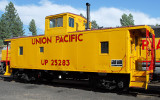
| Builder | UP in its Omaha Shops |
| Built | August 1952 |
| Type | UP Class CA-5 |
| Length | 40 ft. 5 1/4 in. Interior length 30 ft. 1 3/8 in. |
| Operating weight | 53,200 lbs |
| Acquisition | Donated by Union Pacific 1985 |
The UP 25283 is an example of a UP Class CA-5 caboose. It was built in August 1952 as UP 3983 by UP in its Omaha Shops, using welded steel under frames from International Car, and body components from Youngstown Steel Door Co. (which is why there is a small plate on each side of the car with a "Y" on it). It was renumbered in June 1959 to 25283 and was never upgraded for pool service.
In July 1984 it was painted silver and renumbered UP 903005MW and placed in Maintenance-of-Way service and assigned to the Portola outfit train. Known then as the "Silver Palace" she was donated to FRRS in 1985. In 2001 the FRRS repainted the "Silver Palace" back to yellow as number 25283.
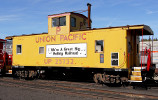
| Builder | International Car Co. |
| Built | September 1975 |
| Type | UP Class CA-10 |
| Operating weight | 55,000 lbs |
| Acquisition | Museum equipment trade between the FRRS and the Western Railway Museum in May 2005 |
UP25732
Union Pacific caboose 25732 was built in September 1975 by International Car Co. of Kenton OH. Caboose is a steel center cupola, Model CA-10. She was acquired in a museum equipment trade between the Feather River Rail Society and the Bay Area Electric Railway Association in May 2005.
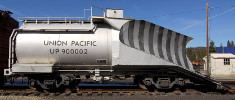
UP 900002 Snow Plow
The winter of 1948-1949 went into the record books as the nastiest and longest snow blockade in the history of the Union Pacific. Snow fighting equipment was challenged to its fullest capacity.
Prior to the storm, the Union Pacific had 19 wedge snow plows available, mostly single track type except for three double track plows. These were wooden bodied and most had wood under frames. The most modem of these wedge plows was built on a flat ear in 1928, while the majority dated back to between 1914 and 1920.
UP decided to convert twelve 12,000 gallon (four wheel truck) steam locomotive tenders into snow plows. The work was done in UP’s own shops.
UP 900002 was the second conversion. It was built in September 1949 at the Pocatello Idaho shop. It was created from tender 12-C-213 which had served with steam locomotive 3562. To keep it on the rails while plowing snow, this car’s former water tank is heavily ballasted with rock and weights 229,420 pounds.
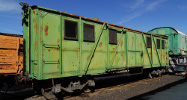
US Army Ammo Car
This unusual car has a complex and interesting history. It started out as a US Army ammo car, declared surplus and was then used for payroll and MOW service. It ended its commercial life as an outfit car for the Clover Valley Lumber Company.
It was built in April 1919 as an artillery fire control car for use with one of the big railway guns built during WWI. The car probably had wood siding when built (Texas State Railroad Museum has similar cars with wood siding). The car was later rebuilt with steel sheathing and has trucks built in 1936.
In U.S. Army service, it carried the number ODKX 2. It was probably declared surplus, purchased by a railroad equipment dealer and sold to Clover Valley Lumber Company. The car was used in log trains hauling loggers and supplies to the logging camps in Clover Valley. It may also have been used as a bunk car in remote areas. In that service, it was known as a "cootie car."
The car was donated to the Feather River Short Line Railroad in 1958. The Feather River Short Line Railroad was a non-profit corporation organized to preserve logging equipment from the area. The car was moved to Quincy and stored on the Quincy Railroad. Eventually it was retired and placed on static display at the Plumas County Fairgrounds.
When our museum was getting started, we invited the FRSL to move its equipment to Portola. After several years with us, the outfit car was moved back to Quincy for storage. Because of a need to use the storage space for other purposes, the car was given to the Sloat Mill Company and moved to a siding track at Sloat in 2000.
In 2001 the car was donated to the FRRS and moved to Portola again where she remains today.

| Builder | Fairbanks, Morse & Co. |
| Built | January 1953 |
| Type | H12-44 |
| Horsepower | 1200 |
| Serial number | 12L681 |
| Original cost | $224,700 |
| Top speed | Max speed is 40-45 mph (It has 14:68 gearing, which is good for 60 mph, but the trucks it's on are only good for 40-45 mph.) |
| Operating weight | 246,000 lbs |
| Acquisition | Purchased by FRRS |
United States Army 1857 – Diesel Electric Switching Locomotive
This locomotive was build by the firm of Fairbanks, Morse and Company in Beloit, Wisconsin. F-M was a relative latecomer to the diesel locomotive industry, but tried to break in with an unusual and innovative prime mover design using opposed piston engines. While ultimately unsuccessful in locomotive applications, F-M's prime movers remain in production today and are used for naval vessels and power generators.
Between May 1950 and March 1961, 336 of this model were built, WP neighbors Southern Pacific and Denver & Rio Grande Western both rostered them. However, F-M could not compete with the larger builders. It sold its last domestic locomotive in 1958 and its last locomotive ever left the factory in 1963. Today, only a handful of running F-M locomotives remain, predominantly in museums.
It is currently displayed as Feather River & Western, a fictitious railroad.
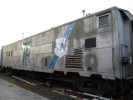
USAF G50
During World War II, mobilization of fighting troops by rail resulted in huge increases in traffic. Passenger miles would quadruple during 1940-1944.
The basic challenge was made worse by a lack of equipment and a War Production Board that would not allow the building of new passenger cars. A solution was found when the Pullman Company constructed a total of 2,400 troop sleepers between 1943-1945. In addition to the sleepers, 800 kitchen cars were built.
USAF G50 started life as 1943 US Army Troop kitchen car number 8750. After the war it was rebuilt as a guard car for the US Air Force Strategic Air Command and was used when transporting “special” material by rail. Its last use, as far as can be determined, was August 1983 for "Mission Capable."
The car was purchased on a sealed bid sale from Hill AFB, Utah by Norman Holmes and donated to the museum in 1990. It is currently used as an office by the museum.

View a short video of the the Wig-Wag in action HERE!
| Builder | Magnetic Signal Company of Los Angles |
| Built | circa 1930 |
| Type | MAGNETIC FLAGMAN |
| Acquisition | Donated by Dr. Cheryl Meeker in memory of Ken Meeker |
The “MAGNETIC FLAGMAN”, and other similar warning signals, were used extensively at grade crossing throughout the United States during the early-to-mid 20th Century. Our Wig-Wag was donated to the Feather River Rail Society by Dr. Cheryl Meeker in memory of Ken Meeker.
Our wig-wag was made by Magnetic Signal Company of Los Angles and the base was made by Union Switch & Signal, Swissvale PA.
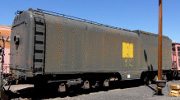
WPMW 27-2
Western Pacific Maintenance-of-Way 27-2 was last used as the fuel and water tender for WPMW derrick 27. Lima Locomotive Works originally built it in July 1943 for use with steam locomotive WP 484. It has a capacity of 23,000 gallons. This tender is the only remaining tender from the Western Pacific's GS-64 series locomotives.
Western Pacific No. 484 was a Class GS-64 semi-streamlined 4-8-4 "Northern" type steam locomotive. The locomotive spent years working on the Western Pacific Railroad hauling passenger trains and in freight service as well.
No. 484 was retired when the Western Pacific dieselized and they sold her to the Southern Pacific railroad for spare parts.
In 1953, when locomotives WP 481 - 486 were retired, their tenders were saved, those from 481, 484 and485. They were then renumbered 81, 82 and 83 respectively and outfitted as diesel-water cars for maintenance-of-way service.
WP Rotary 3 got tender #81 and Rotary 4 got tender 82 and 83 was a spare and scrapped just a few years later. Tender 82 was renumbered to WPMW 27-2 in the early 1970's and assigned to derrick 27.
Special thanks for research by Chris Jacobsmeyer.
Additional information from Locomotive Wiki. Western Pacific No. 484 Retrieved June 20, 2018, from http://locomotive.wikia.com/wiki/Western_Pacific_No._484
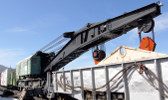
Western Pacific MW 37 derrick
The Western Pacific's big hook. While WP had several derricks and cranes (three of which, of varying sizes, are preserved at the museum), MW 37 was the largest, capable of lifting 200 tons. Built by Industrial Brownhoist in 1937, the 37 was originally steam powered. Its builder number is 5256 and it is a self-propelled Z type 200 ton derrick.
Most often stationed at Oroville for use in the Feather River Canyon, the 37 had a complete support train, many pieces of which are also preserved at the WPRM. In 1971, it was repowered with a six cylinder, turbocharged Caterpillar engine by Holt Brothers in Stockton, CA.
Today, we maintain the 37 in fully operational condition, one of the few preserved "big hooks" that still sees use.
It was donated by Union Pacific to the society.
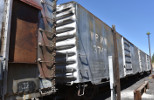
| Builder | Pullman-Standard |
| Builder Lot Number | 8240 |
| Built | July 1955 |
| Type | PS-1 XM Boxcar |
| Volume | 4844 cubic ft |
| Capacity | 50-tons |
| Operational Weight | 52,000 lbs |
| Interior Length | 50 ft 5-9⁄16 in |
| Interior Width | 9 ft 2-1⁄16 in |
| Interior Height | 10 ft 5-1⁄2 in |
| Length Over Strikers | 51 ft 10 in |
| Overall Width | 10 ft 5-1⁄16 in |
| Overall Height | 14 ft 11-15⁄16 in |
| Clear Door Opening | 8 ft 0 in wide X 9 ft 10-5⁄16 in high |
| Door Type | Superior 6-panel sliding |
| Trucks | Scullin A-3 Ride Control |
WPMW 37-10
For most of its history, Tidewater Southern was a subsidiary of the Western Pacific Railroad. The Tidewater's 501 series boxcars comprised 25 cars delivered in July of 1955. They were the first real fleet of interchange freight cars owned by the railroad.
In 1975, the WP made plans to renumber all the former Tidewater Southern 501 series boxcars into its 36026 series, behind its own single door PS-1s, however this was not done quickly nor did it reach all the cars. TS 521 was renumbered directly into WP MOW service as WPMW 37-10.
WPMW 37-10, the former Tidewater Southern 521 boxcar, is now used for storage and is slated to retain its silver paint.
She came to us when elements of the WPMW 37 wreck train were given to the museum. When the light is just right, you can still see the remains of the colorful cornucopias under the thin MOW silver paint.
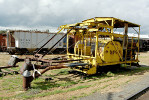
This unique piece of railroad equipment was used to burn weeds along the right away and to thaw frozen switches and melt snow around the yard.
It used #2 diesel as the fuel for the five burners, each at the end of a long boom. Each boom could be raised or lowered individually and moved left or right. Each boom had a foot-pedal lock/release and a wheel that the operator would manually use to move the boom.
To light the burners, the air compressor would be started and the fuel oil would be "cracked" for only the center burner. A lit fussee (a red flare used for flagging or warning purposes) was placed under the center burner and would ignite the fuel/oil mixture. Then the outer burners on each side would be activated and would ignite from the center burner.
It is believed it was used until sometime in the 1970's and then was retired.
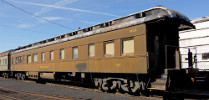
You can watch a five minute video about the history of the WP 106 and the Rededication Ceremony on September 9th, 2017.
(after the video starts you may wish to use the YouTube "Full-screen" option to enlarge the video if you are using a mobile device.)
| Builder | Pullman Company |
| Built | September 1917 |
| Type | Business Observation |
| Plan number | 2502C |
| Serial number | 4490-3 |
| Overall length | 18 feet 11 inches |
| Operating weight | 185,880 lbs |
| Acquisition | Acquired by FRRS |
WP 106 – Pioneer – Charles O. Sweetwood
Hiding in plain view at the WPRM, this old Pullman is probably the most famous single passenger car from the Western Pacific Railroad and for a time during the 1950's, was one of the most famous railroad cars in the western United States. It helped gather the blood that saved the lives of countless soldiers wounded in the Korean War.
Built in 1917 by the Pullman Company for its leased fleet, the car was named the “Pioneer”. The car was sold to the Western Pacific Railroad in May of 1942.
Early in the 1950’s Korean war, it was decided to create a rail-based blood donation center. The “Pioneer” was chosen for this new service.
The Western Pacific decided to rename the car after the first WP employee who had died in the Korean conflict. With the name of “Charles O. Sweetwood”, the 106 became the first blood procurement car in the U.S. for the Korean War.
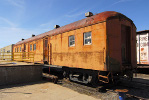
| Builder | Presses Steel Car Co. |
| Built | December 1923 |
| Type | Steel Baggage Express (specification number 2236) |
| Length | 63 feet 3 inches |
| Height | 14 feet 1 inch |
| Original cost | $16,641 |
| Operating weight | 102,000 lbs |
| Acquisition | Donated by Union Pacific |
WP 123 is a rare example of a passenger car built by the Pressed Steel Car Company. It was one of twenty baggage cars purchased by the WP in 1923-1924. These cars were used on all the WP's long distance trains, including the flagship, Scenic Limited and its successor the Exposition Flyer, until the arrival of the stainless steel California Zephyr.
The Pressed Steel Car Company was formed in 1899 via the consolidation of two other firms that had pioneered techniques in steel rail car construction. It continued to be an innovator, using custom pressed shapes to produce steel and steel underframe cars, particularly freight cars. Along with other producers in steel designs, it helped lead the transition from wood to steel equipment.
The WP's 121-140 were the only all-baggage cars on the railroad until new baggage cars arrived for the California Zephyr. WP 123 was heavily modified in the mid-1950s for maintenance-of-way service and survived until the early 1980s when it was donated to the FRRS by the Union Pacific Railroad.
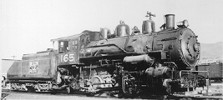
Western Pacific 165 Alco 0-6-0 Steam Locomotive
Western Pacific 165 is an 0-6-0 switching locomotive built by the Schenectady Works of the American Locomotive Company. This engine was used at many of the WP's railyards, including Stockton, Sacramento and Portola. It was built in November, 1919, for the United Verde Copper Company of Jerome, AZ, as their number 87. On September 17, 1927, the 165 and three sister UVCC engines were sold to the WP and become the road's S-34 class, numbered 163-166.
These burly switchers supplemented WP's 12 existing 0-6-0s. The 165 last operated in March, 1953, as WP was winding down its steam operations. The engine was retired in October, 1957. Five years later, it was donated to the City of San Leandro. The engine was displayed for many years at the San Leandro BART station before being transferred to the Alameda County Fairgrounds. It was later acquired by the Pacific Locomotive Association and came to the FRRS in a trade with a later owner.
On March 1, 2006, the 165 returned to Portola on a museum flatcar, marking the return of WP steam power to Plumas County for the first time in nearly 50 years. Work has now begun on a restoration of the engine, hopefully to complete operation.
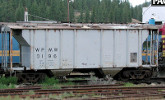
WPMW 0196 was acquired by the Western Pacific in April of 1956 as part of a 10 car order. The original car numbers of this order were 11201 - 11210. We are not sure which original number was assigned to this car.
The car was built by Pullman-Standard as a 70 ton, two bay covered hopper. It has a capacity of 2003 cubic feet. The car, as delivered, rode on ASF type A-3 Ride Control trucks.
Commodities commonly carried by this type of car included, but were not limited to, cement, sand, potash, soda ash, lime, fertilizers, plastic pellets, and flour.
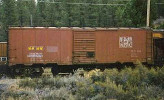
By the 1930s, wood body cars were obsolete. WP began purchasing steel flatcars and hoppers (as well as passenger cars) in the 1920s, but 1937 saw the first brand new steel boxcars join the roster. The railroad had rebuilt a few wood auto boxcars with steel bodies, but the 20001 series cars delivered by Mt. Vernon Car Company were the first major upgrade of the boxcar fleet in 20 years. This fleet of 200 cars were unusual in that they were built with bodies only 9' 6" high, at a time when most boxcars were 10' or more.
Several lasted in MOW service into the early 1980s, but only this one survives today. Fifteen of these cars were rebuilt for passenger train express service with a special MERCHANDISE DISPATCH paint scheme in 1941.
It was donated by Union Pacific to the museum.
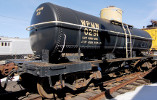
WPMW 0291
This tank car was build by Union Tank Car Company. The Union Tank Car Company, or UTLX (their best-known reporting mark), is a railway equipment leasing company (and car maintenance / manufacturing) headquartered in metro Chicago, Illinois. As the name says, they specialize in tank cars.
Union Tank Car Company was founded in 1866 by Captain Jacob J. Vandergrift, in response to the economic activities of John D. Rockefeller in the years leading up to his creation of Standard Oil.[1]
This car was built in April 1952, originally as UTLX 9284. It is a 39 foot, 10,000 gallon, one dome tank car. Union Tank Car Company used it in their lease fleet. It was acquired by WP and eventually was sold to the Feather River Rail Society for our museum.
[1] WIKIPEDIA. (2018). In Union Tank Car Company. Retrieved April 12, 2018, from https://en.wikipedia.org/wiki/Union_Tank_Car_Company
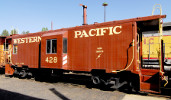
| Builder | International Car Co. Kenton, OH |
| Built | November 1955 |
| Type | Assigned UP class CA-14 after merger |
| Operating weight | 50,000 lbs |
| Acquisition | Donated by Union Pacific 1984 |
The WP 428 caboose was donated by UP to the FRRS in June 1984. It is a steel bay window caboose built in November 1955 by the International Car Co. in Kenton, OH. After the WP-UP merger, it was assigned UP class CA-14.
The FRRS repainted it in 2001.
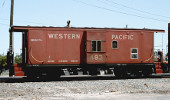
| Builder | Internal Car Co. Kenton, OH |
| Built | May 1980 |
| Type | Assigned UP class CA-18 on paper after merger |
| Operating weight | We have two sources that differ on the weight of this caboose. One source says 55,700 lbs. The second says 55,700 lbs. |
| Acquisition | Acquired by FRRS as part of the equipment trade with Western Railway Museum in 2005 |
WP483
Western Pacific caboose 483 was built in May 1980 by International Car Co., Kenton OH. The caboose was acquired in a museum equipment trade between the Feather River Rail Society and the Bay Area Electric Railway Association in May 2005. Caboose is slated to be cleaned up and placed into service as the general superintendent's office.
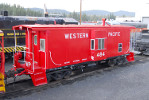
| Builder | International Car Co. |
| Built | May 1980 |
| Type | Steel Bay Window Caboose |
| Length | 37 feet 0 inches |
| Original cost | $181,538 |
| Operating weight | 55,700 lbs |
| Acquisition | Donated by Union Pacific |
Western Pacific Railroad 484 – Steel Bay Window Caboose
WP 484 represents the Western Pacific's final order for cabooses. While boasting the latest accessories when it was built, overall the 484 is very similar to the first steel cabooses the WP acquired 25 years earlier. There are some differences, however. Unlike the railroad's other steel cabooses, which used a common design, WP 484 and her five sister cars were based on a Southern Pacific Railroad design and were built following a big order for the WP's main rival.
Western Pacific was an early convert to the bay window design, building their first version in 1942. The Southern Pacific debuted bay windows in 1949 and both railroads stayed with the design. In contrast, fellow California railroad Santa Fe remained with the cupola design until the end of widespread caboose use.
The 484 was retired in June 1988 only eight years old. WP 486, the final caboose in the order, was the last WP caboose in service, retired by the Union Pacific in April 1983.
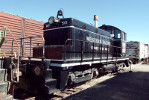
| Builder | Electro-Motive Corporation, division of General Motors |
| Built | August 1939 |
| Type | SW1 |
| Horsepower | 600 |
| Serial number | 906 |
| Original cost | $64,525 |
| Top speed | 45 MPH |
| Operating weight | 201,000 lbs |
| Acquisition | Donated by Corn Products |
This little engine was the Western Pacific's first diesel-electric locomotive. Sent west by the Electro Motive Corporation in 1939 to demonstrate the virtues of diesel power to the WP. Management liked what it could do and authorized the purchase of the engine and the building of two sisters within two months of its arrival. Less than fourteen years later, the WP became the first large western railroad to be completely dieselized.
The 501 worked at a number of terminals, including San Francisco, where it was needed to eliminate smoke and steam while spotting cars inside a can factory. Early in her career, the engine most often worked the yards and spurs in Oakland or San Francisco.
In 1980, the 501 was refurbished and sold to Corn Products Corporation in Stockton for use as a plant switcher. In 1987, Corn Products donated the locomotive to the Feather River Rail Society.
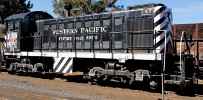
| Builder | American Locomotive Co. |
| Built | November 1941 |
| Type | S-1 |
| Horsepower | 660 |
| Serial number | 695146 |
| Top speed | 60 MPH |
| Operating weight | 202,000 lbs |
| Acquisition | Hill Air Force Base in Utah General Surplus Sale. It came to us as USA 7372. |
WP 512 is not a real Western Pacific Locomotive. WP 512 was built for the United States Army in 1941 and was made available after retirement through the Government Surplus Program.
Early in the museum's history, the Feather River Rail Society desired an operating ALCO "S" series switcher, and thus purchased the 512, and then painted it into the paint scheme representative of the first ALCO S1s on the Western Pacific. WP's ALCO S-1's were numbered 504-511, so the FRRS logically numbered their new locomotive "512" following the WP's numbering scheme as that would have been the next available number on WP's roster.

| Builder | American Locomotive Co. |
| Built | May 1951 |
| Type | S-4 |
| Horsepower | 1000 |
| Serial number | 78777 |
| Top speed | 45 MPH |
| Operating weight | 231,000 lbs |
| Acquisition | Purchased by two society members and donated to the FRRS |
About 1991 the FRRS made an inquiry to Foster Farms to acquire former WP 563. This 1,000 hp ALCo S-4, one of only two owned by WP, was purchased by Foster Farms in December, 1976, and used as a switcher at their Livingston, CA feed storage facility. It was replaced by a former SP ALCo S-6 and remained as a standby unit and later as a parts source.
In October 1996 we were notified that the unit was available at a reasonable price. However, since the museum's financial condition was not as strong as we would have liked, Norman Holmes and John Ryczkowski agreed to purchase the locomotive, restore it to operating condition (unless major problems are revealed) and then donate it to the museum.
Western Pacific #563 was one of only two switch engines on the system to have been painted in all of the WP's switcher paint schemes over the years. Delivered in 1951 in black and white paint, (like the WP 501 and 512), she has worn silver and orange, solid orange, and in the 1970's, was painted in Perlman Green and orange paint.
WP took delivery of two Alco S-4 1,000 hp units in June 1951. After serving the required time in Nevada to avoid California sales tax the units 563 and 564 were sent to Keddie to work the Westwood turn.
Later EMD's GP7s took over the Westwood turn, releasing the Alcos for service elsewhere. 563 then spent time in San Francisco and San Jose.
By the mid 70's WP's Alco switching days were over. Number 563 was sold in October 1973 to the Central California Traction. Number 563 worked on the CCT until November 1976 when it was returned to WP in exchange for RS-1, TS 746. WP immediately sold the 563 to Foster Farms for switching duties at its Livingston feed storage facility. It served Foster Farms until 1985.
In October 1996 the unit was offered for sale to our Society. Our organization did not have sufficient funds for the purchase at the time so two members purchased the unit and then donated it to the FRRS.
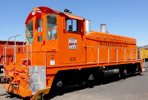
| Builder | Electro-Motive Division of General Motors |
| Built | May 1940 |
| Type | NW2u |
| Horsepower | 1200 |
| Serial number | 1000 |
| Original cost | $181,538 |
| Top speed | 45 MPH |
| Operating weight | 248,000 lbs |
| Acquisition | Donated by Union Pacific |
WP 608 – Diesel Electric Switching Locomotive
The WP 608 was built before World War II for the Union Pacific Railroad. It was the first diesel-switching locomotive to be purchased new by the UP. Numbered DS-1001, this sturdy switcher worked for the Union Pacific until the late 1960’s. It was sold and eventually ended up on the Western Pacific as WP 608 in 1968.
The unit was rebuilt and served until the end of the Western Pacific. The 608 spent most of its WP service working yards in Stockton and Sacramento. WP 608 was retired less than one year after the Union Pacific acquired the WP, being set aside in September 1983.
UP donated it to the FRRS in late 1984.
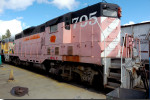
| Builder | Electro-Motive Division of General Motors |
| Built | October 1952 |
| Type | GP7 |
| Horsepower | 1500 |
| Serial number | 17029 |
| Top speed | 65 MPH |
| Operating weight | 251,700 lbs |
| Acquisition | Purchased and donated by a group of FRRS members |
WP 705 Came to the Western Pacific Railroad Museum from Arizona where she spent several years working in the desert hauling freight for short line "Arizona Central" after retirement from the Western Pacific. This explains the faded red paint. 705 was purchased by a group of FRRS members and brought "home" in 2005. Nicknamed the "Mary Kay" due to its pink (faded red) paint, the 705 will be restored as time and money allow. Once mechanical restoration is completed, it will be pained the Perlman Green and Orange paint scheme. For the time being, WP 705 is stored at the museum on display.
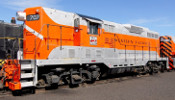
| Builder | Electro-Motive Division of General Motors |
| Built | October 1952 |
| Type | GP7 |
| Horsepower | 1500 |
| Serial number | 17031 |
| Original cost | $170,922 |
| Top speed | 65 MPH |
| Operating weight | 251,700 lbs |
| Acquisition | Donated by Union Pacific |
Western Pacific Railroad 707
The first diesels to replace steam locomotives in large numbers were mostly "carbody" type engine, where the body was full width, with no walkways and the form was often streamlined.
Beginning in the 1940's, however, locomotive builders began putting narrow hoods on their larger locomotives, creating motive power suitable for mainline freight trains, but having the visibility to allow its use as a switching engine. The "road switcher" body quickly became the dominant style for freight locomotives, one which continues today. The 707 represents the first model made by the Electro-Motive Division of General Motors using this style, and was part of the first order of such locomotives delivered to the Western Pacific.
The 707 and her sisters had long careers on the Western Pacific, their versatile and rugged design proving its worth. Most would serve until after the Union Pacific merged the WP in December 1982.
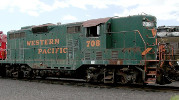
| Builder | Electro-Motive Division of General Motors |
| Built | October 1952 |
| Type | GP7 |
| Horsepower | 1500 |
| Serial number | 17056 |
| Original cost | $170,922 |
| Top speed | 65 MPH |
| Operating weight | 251,700 lbs |
Western Pacific 708 has been described by members and visitors in many ways, but "beautiful" is not usually one of them.
Since we have three other examples of WP and Sacramento Northern GP7's, we felt it important to preserve and present the 708 in its "as working" appearance. It is important to note that locomotives are rarely kept polished or have their paint touched up when in service on the railroads. Despite the WP's system locomotive shop in Stockton having a fully functioning wash rack to keep the roads locomotives clean, most of the older locomotives like the 708 only came home to Stockton for repairs or maintenance, and immediately sent back to work.
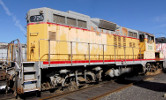
| Builder | Electro-Motive Division of General Motors |
| Built | September 1955 |
| Type | GP9 |
| Horsepower | 1750 |
| Serial number | 20696 |
| Top speed | 65 MPH |
| Operating weight | 247,600 lbs |
| Acquisition | Purchased by FRRS |
The Western Pacific Railroad had eight GP-9 locomotives, numbered 725-732.
When the Union Pacific acquired the WP in 1982, six of the eight were still on the roster and four of them (725, 729, 731 and 732) were repainted into UP colors and renumbered UP 300, 304, 306 and 308. These units saw service on many areas of the old WP and SN until 1984 when they were sold to a regional railroad in Iowa.
In 1995, the FRRS purchased two of these units (ex WP 725 and WP 731) and brought them home to Portola. The 725 and 731 are two of the only three remaining WP GP9s. The other WP 727 is on display in Elko Nevada.
Cosmetically these units are not much to look at, but with one look into the engine compartments, it is clear that we have well-maintained units on our hands. They should be excellent runners after restoration is completed.
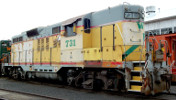
| Builder | Electro-Motive Division of General Motors |
| Built | September 1955 |
| Type | GP9 |
| Horsepower | 1750 |
| Serial number | 20754 |
| Top speed | 65 MPH |
| Operating weight | 247,600 lbs |
| Acquisition | Purchased by FRRS |
The Western Pacific Railroad had eight GP-9 locomotives, numbered 725-732.
When the Union Pacific acquired the WP in 1982, six of the eight were still on the roster and four of them (725, 729, 731 and 732) were repainted into UP colors and renumbered UP 300, 304, 306 and 308. These units saw service on many areas of the old WP and SN until 1984 when they were sold to a regional railroad in Iowa.
In 1995, the FRRS purchased two of these units (ex WP 725 and WP 731) and brought them home to Portola. The 725 and 731 are two of the only three remaining WP GP9s. The other WP 727 is on display in Elko Nevada.
Cosmetically these units are not much to look at, but with one look into the engine compartments, it is clear that we have well-maintained units on our hands. They should be excellent runners after restoration is completed.
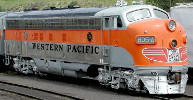
| Builder | Electro-Motive Division of General Motors |
| Built | January 1950 |
| Type | FP7 |
| Horsepower | 1500 |
| Serial number | 9004 |
| Top speed | 100+ MPH |
| Operating weight | 252,800 lbs |
| Acquisition | Purchased by three society members and the FRRS |
Photos of Mars light mechanism HERE!
Western Pacific 805-A was built by the Electro Motive Division of General Motors in 1950 as part of an A-B-A set of 2 "cab" units and 1 cabless "booster" unit for the road’s flagship "California Zephyr" passenger train.
This cab unit, typically accompanied by two cabless "B" units, hauled the train between Oakland and Salt Lake City from 1950 until March 22, 1970, when the train was discontinued.
The 805-A was then placed in freight service, traded in for credit, resold and transferred to another railroad in Pennsylvania. After that railroad was abandoned in 1977, she went to Louisiana and worked until she needed a major overhaul.
Arrangements were made to purchase the locomotive in 1987 with the cost shared between three society members and the FRRS.
WP 805A is the last WP California Zephyr locomotive in existence.
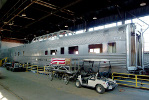
WP 832– California Zephyr Vista Dome Lounge-Dormitory Car
This car, named the “Silver Hostel” was built by the Budd Company in November 1948. The “Silver Hostel” was the lounge-dorm car on the very first eastbound CZ and served until the end of CZ service.
This car is one of six Vista Dome-Lounge Dormitory cars built as part of the original CZ car order. The dome is its most noticeable exterior feature. An icon of the CZ, this 24 seat “penthouse” would be one of five on a CZ consist, trailing immediately behind three dome coaches. The car resided near the middle of the train, leading the diner, sleepers, and the rear dome observation car.
The buffet lounge occupies one end of the car, with the kitchen located under part of the dome. Here, passengers ordered snacks, drinks, and light lunch items. In the early 1960’s, all six cars were remodeled as “The Cable Car Lounge”, designed around a San Francisco theme. This variant would become nationally famous as the subject of many well-remembered ad campaigns.
The dormitory section provided quarters for members of the CZ crew, including bedrooms for the Zephyrette hostesses. All crewmembers shared a full bathroom located under the dome.
After passing through many owners, the “Hostel” was purchased by the FRRS for restoration and display.
The original California Zephyr ran over the Chicago, Burlington and Quincy Railroad from Chicago to Denver; the Denver and Rio Grande Western Railroad between Denver and Salt Lake City and the Western Pacific Railroad from Salt Lake City to Oakland. Cars owned by different railroads ran together in the train.
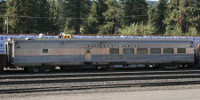
| Builder | Budd Company |
| Built | November 1948 |
| Type | Dining Car (lot number 9624-021) |
| Length | 85 feet 0 inches |
| Original cost | $134,936.06 |
| Operating weight | 158,670 lbs |
| Passenger capacity | 48 seat dining room (convertible to 40 seat) |
| Acquisition | Donated by California State Railroad Museum |
Western Pacific Railroad 841 "Silver Plate" – California Zephyr Dining Car
The dining car has long been one of the social centers and highlight experiences of a train journey. Six dining cars were built for the California Zephyr, all bearing restaurant and meal themed names. Today the "Silver Plate" is the last of these cares to survive intact and unaltered. She was built in November 1948.
The car seats 48 people using four seat tables: 32 in the main section and 16 in nooks at each end of the car.
Dinner was the most popular meal. Up to six seatings were required, by reservation, to serve the large number of diners. During initial check-in, passengers made reservations for their preferred time with the Zephyrette hostess and received a reminder card. There were no reservations for breakfast or lunch.
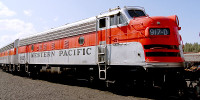
You can OPERATE this locomotive...see our Run-A-Locomotive program to learn how!
| Builder | Electro-Motive Division of General Motors |
| Built | February 1950 |
| Type | F7A |
| Horsepower | 1500 |
| Serial number | 8971 |
| Original cost | $671,530 (4 unit set with 2 cab and 2 booster units) |
| Top speed | 60 MPH |
| Operating weight | 237,750 lbs |
| Acquisition | Donated by Bay Area Electric Railway Association |
Western Pacific Railroad 917-D
WP 917-D was part of WP's first order for the F7 model, all delivered as four unit sets lettered A-D (A and D units had control cabs). These "F-units" served until newer models with higher horsepower and better visibility rendered them obsolete. The WP was slow to retire them, however. The railroad was always too short of money to completely replace many older engines, which could still earn a profit. By 1977, when most railroads had long since replaced their full carbody style locomotives, the WP still rostered four. That year, two of the survivors were sent to Morrison-Knudsen in Boise, ID for rebuilding, while 917-D was rebuilt by WP in Stockton.
For the next three years, the newly christened "Fab 4" continued to earn their keep while generating great publicity for the WP, typically working the regular train between Stockton and San Jose.
After the Union Pacific merger, the 917-D was retired and donated to the Bay Area Electric Railway Association. In 2005, it came to Portola as part of a large equipment trade between the organizations.
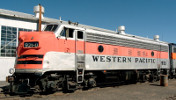
| Builder | Electro-Motive Division of General Motors |
| Built | February 1950 |
| Type | F7A |
| Horsepower | 1500 |
| Serial number | 8979 |
| Original cost | $671,530 (4 unit set with 2 cab and 2 booster units) |
| Top speed | 60 MPH |
| Operating weight | 237,750 lbs |
| Acquisition | Donated by Union Pacific |
Western Pacific Railroad 921-D
WP 921-D was the last unit delivered in WP's first order for the F7 model, all delivered as four unit sets lettered A-D (A and D units had control cabs). These "F-units" served until newer models with higher horsepower and better visibility rendered them obsolete. The WP was slow to retire them, however. The railroad was always too short of money to completely replace many older engines, which could still earn a profit. By 1977, when most railroads had long since replaced their full carbody style locomotives, the WP still rostered four. That year, two of them, including the 921-D were sent to Morrison-Knudsen in Boise, ID for rebuilding.
WP rebuilt 917 and rewired 918 in Stockton.
For the next three years, the newly christened "Fab 4" continued to earn their keep while generating great publicity for the WP.
After the Union Pacific merger, the 921-D was retired and donated to us here at the Feather River Rail Society.
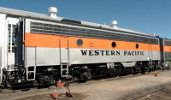
The WP925C is usually not open to the public, but you can scroll down this page and see some interior photos.
| Builder | General Motors Diesel Division - Canada |
| Built | June 1951 rebuilt by CN in 1972. |
| Type | F7Bu (u indicates upgraded) |
| Horsepower | 1750 |
| Serial number | A-214 |
| Original cost | $168,00 (approximate USD) |
| Top speed | 65 MPH |
| Operating weight | 249,000 lbs |
| Acquisition | Purchased by FRRS |
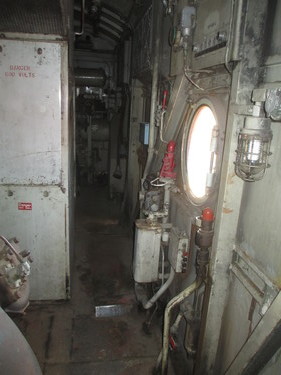
Unbeknownst to most people, many of the cabless “B” booster units could move under their own control. In our EMD F7B unit, the hostler controls are located next to the front porthole window on the right side.
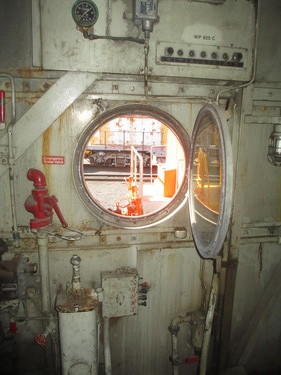
The window could be opened and the hostler would stick their head out to see while the hostler moved the locomotive. The hostler controls were used mainly to move a solo B unit around a service or maintenance facility.
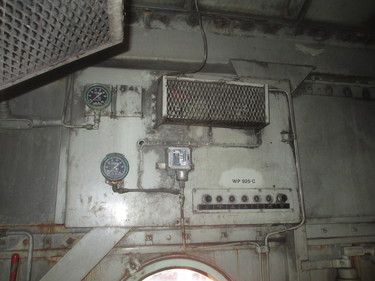
All of the usual locomotive controls: throttle, brake stand, emergency brake, indicated lights, etc. were located within reach.

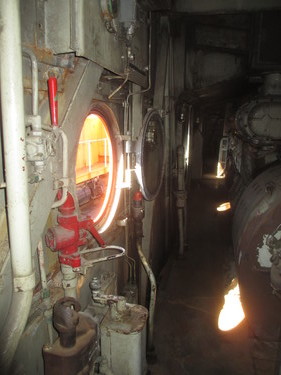
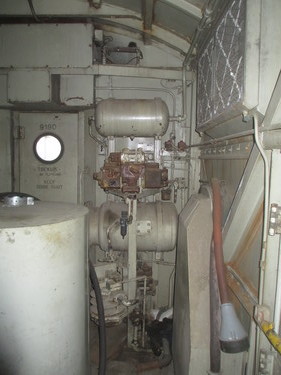
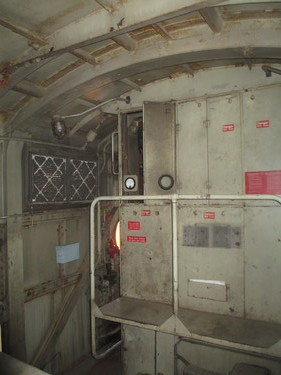
Electrical cabinets
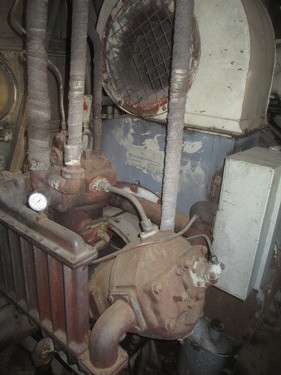
Air Compressor
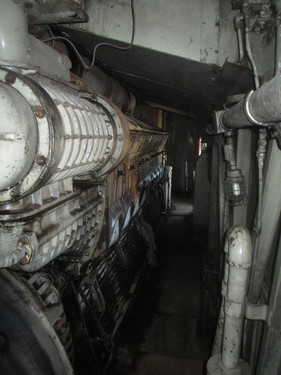
Looking down the side of the 1,750 horsepower EMD 567 - 16 Cylinder Supercharged prime mover.
Photos by Paul Finnegan - 8/12/2017
Western Pacific's "covered wagons" (an affectionate nickname for these carbody type
locomotives) fleet consisted of an equal number of "A" cab control units and "B"
cabless booster units.
As the units aged and were traded in on new, higher horsepower units, the "B" units
were often first to go due to their limited versatility compared to the cabbed units.
By the time the FRRS established the Western Pacific Railroad Museum, all of the Western Pacific’s "B" units were gone or beyond salvage.
Still, a "B" unit was desired to represent this type of locomotive in our collection.
In the late 1980s, the Canadian National Railway still had some "B" units which had
recently been sold for scrap. Arrangements were made to purchase one of the units in operating condition and restore it to represent a WP freight "B" unit.
This unit, built as CN 9039, was repainted in WP's classic orange and silver "Zephyr"
paint scheme and given a fictitious WP number based on the railroad’s own number scheme.
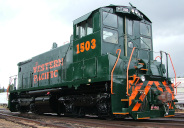
| Builder | Electro-Motive Division of General Motors |
| Built | May 1973 |
| Type | SW 1500 |
| Horsepower | 1500 |
| Serial number | 72692-3 |
| Top speed | 60 MPH |
| Operating weight | 257,870 lbs |
| Acquisition | UP donated the 1503 to the FRRS in October 2011 |
Western Pacific 1503 was built in La Grange, Illinois at the Electro Motive Division of General Motors in May of 1973 at a cost of $207,134. As part of an order of three locomotives numbered 1501-1503. These three locomotives were the last switching locomotives built for the Western Pacific. The 1503 could usually be found throughout the 1970's and 80's working the industrial areas of San Francisco.
Due to the merger between the Western Pacific and Union Pacific in December of 1982, the UP retired older Western Pacific locomotives, selling several to shortlines, scrapping a few and graciously donated several to the brand new Feather River Rail Society. The SW1500's however, were a very modern engine and were retained for use by the UP. Soon, the small fleet was repainted in Union Pacific's Armour yellow and Harbor Mist gray scheme and sent back to work in the San Francisco bay area and Stockton.
Eventually, UP decided to sell off it's SW1500 fleet, opting for small road switchers instead to fill in for the local and switching duties often handled by the 1500's and auctioned them off to various shortlines and leasing companies. WP 1503 joined her sisters on the auction block in East St. Louis Illinois in 2011. At a time when most large road locomotives went for around $150,000 at auction, SW1500's because of their dependability, rugged power, small stature and the fact that nobody has mass produced a switch engine since the EMD 1500 series, most SW1500's went go for upwards of $200-$250,000 at auction.
Realizing the historical significance of the 1503 being the last switcher built for the WP, FRRS President Rod McClure appealed to the Union Pacific to donate the engine for preservation at the Western Pacific Railroad Museum. In October 2011, the UP graciously donated the 1503 to the FRRS.
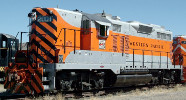
| Builder | Electro-Motive Division of General Motors |
| Built | December 1959 |
| Type | GP20 |
| Horsepower | 2000 |
| Serial number | 25623 |
| Original cost | $212,793.00 |
| Top speed | 65 MPH |
| Operating weight | 256,890 lbs |
| Acquisition | Donated by Union Pacific |
Western Pacific 2001 - Turbocharged Road Freight Locomotive
While it was one of the smallest of the major US railroads, the Western Pacific was often a leader in adopting new technologies and new ideas. One of the most notable is represented by this locomotive: WP 2001.
In the late 1950's, diesel locomotive builders were beginning to toy with new ways to increase the power of the engines in their locomotives. Several had turned to turbocharging, but the Electro-Motive Division of General Motors (also known as EMD), the industry leader, resisted due to fears about poor reliability. Finally, in 1959, it introduced two new models supporting the company's first turbocharged engines: the six-axle SD24 and the four-axle GP20. Western Pacific was the first railroad to purchase the GP20 and the 2001 was the very first GP20 built.
The 2001 and her nine sisters served the WP for over 20 years, lasting until a few years after the December 1982 merger with the Union Pacific. They worked nearly every task the railroad had, from priority mainline service to the lowly local trains. Retired in early 1985, the 2001 was requested by donation by the WPRM.
Due to its historical significance, the 2001 is considered one of the "crown jewels" of our collection. A full restoration of the locomotive, including repainting into its original "Zephyr" paint scheme, was completed in 1999 in time for a much-heralded debut at the California State Railroad Museum RairFair in Sacramento that year.
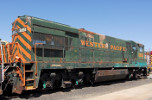
| Builder | General Electric |
| Built | September 1967 |
| Type | U30B |
| Horsepower | 3000 |
| Serial number | 36451 |
| Original cost | $234,458 |
| Top speed | 75 MPH |
| Operating weight | 287,000 lbs |
| Acquisition | Donated by UP in 1985 |
After remaining a loyal EMD customer in regards to road locomotive orders since the EMD FT's, WP turned to General Electric for new road power in 1967. GE had introduced their U30B locomotives in 1965, and WP tested the high-hood demonstrator set soon thereafter. The first five WP bought were actually U30B's in U28B carbodies.
WP purchased five examples in 1967 at a cost per unit of $234,458. WP then went back to GE and ordered fifteen more. U30B 751 was delivered in Silver and Orange with large WP "Feather River Route" medallion on the cab sides, black and orange chevron style warning stripes, signal lights in the nose, and rode on Blomberg trucks from traded in EMD locomotives.
WP's U30B's were retired by successor Union Pacific after the merger, and 3051 was donated by UP in 1985.
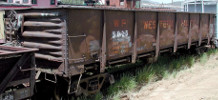
WP 5023 - Drop Bottom Gondola
Western Pacific 5023 arrived at the museum in March, 1990. The drop bottom gondola was built by Pullman Standard in 1953 and was originally numbered in the 9101-9400 series.
It is a 45 foot GS series drop bottom gondola.
In 1960 it was converted to wood chip service with the addition of wood sides and end boards. It featured the "Keep California Green" slogan. After Union Pacific took over WP the wood extensions were removed and the car was returned to general freight service, but usually was used in maintenance-of-way service.
Union Pacific donated this car, it was in storage in Idaho before donation to the museum.
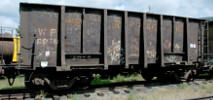
WP 6210 - Oroville Dam Construction Gondola
WP 6210, a 29'-7" gondola was built by Magor in 1963 for the Oroville Dam Constructors. It was one of the ten of these cars later purchased by WP.

| Builder | Greenville Steel Car |
| Built | September 1953 |
| Type | GBS Mill Gondola |
| Length | (inside) 29 feet 4 inches |
| Capacity | 140,000 lbs. |
| Operating weight | 46,800 lbs. |
| Acquisition | Donated by Union Pacific |
This tiny gondola is among the most historically important freight cars in the WPRM collection. Its wheels, specifically the bearings that hold the wheels, represent a sea-change in railroad technology.
From the earliest days of railroading, friction where the rotating axle attached to the framework holding wheel sets, referred to as a "truck", had been a major issue. A type of bearing device, called an "oil waste journal" and commonly referred to as a plain or friction bearing, quickly became the standard for axle bearings. These were prone to failure. When a failure occurred, the bearing would heat up, catch fire, and possibly break apart, a condition referred to as a "hotbox".
Starting in the 1920s, the Timken Company began promoting a "roller bearing" for railroad applications. This bearing required very little lubrication, created less friction and was touted as a money and fuel saving device.
The Sacramento Northern Railway, a WP subsidiary, served a US Steel mill in Pittsburg, California. When the WP needed to expand its fleet of steel coil cars for this mill, they decided to improve on the gondola cars usually used in such service. They purchased 100 of these short mill gons.
Since the coils were so heavy, they overloaded the typical 45' to 50' long cars before they were full, so the builder made the new cars very short for less wasted space.
Most significant was the application of roller bearings. These cars were the first large batch of production freight cars built with sealed roller bearing trucks. WP was at the forefront of this revolution, which was so important that the car s were delivered with a special "Roller Freight" logo. Today, the old "plain bearings" are illegal for regular rail service and the roller bearing reigns supreme.
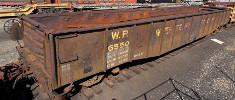
Western Pacific 6550 - Steel Service Gondola
In 1944, the U.S. government built a huge new blast furnace and mill complex at Geneva, Utah, (operated under lease by U.S. Steel). Steel traffic to the West Coast soared, and remained strong when the country shifted to a peacetime economy after World War II.
The traffic boom caused a critical gondola shortage for the WP. The situation eased somewhat when the U.S. Government leased a fleet of mill gondolas to the D&RGW. The WP added 100 of their own 52-foot, 6-inch mill gondolas from Mt. Vernon Car Manufacturing Company in October 1945 (6501-6600).
WP 6550 was from WP's first order of mill gondolas. Union Pacific donated it to the FRRS.
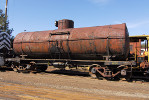
WPMW 1132
This tank car was among the first cars in the Feather River Rail Society collection. It arrived on property on January 7, 1985. It was built in 1912 and is a 10,000 gallon tank car. It was donated by UPRR.
It is used today as our fuel oil car for our steam department.
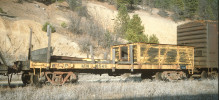
WPMW 8545
Western Pacific Maintenance-of-Way 8545, rebuilt from 75501 series 36' stock car in 1951 was originally built by Pacific Car and Foundry in 1924-1925. It was donated by Union Pacific and arrived at the museum on November 20th, 1984.
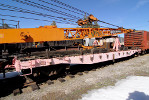
WPMW 8674
Western Pacific MW 8674 is a 50 foot flatcar built by the Mt. Vernon Car Company in November 1942. Union Pacific donated the car to the FRRS and it arrived at the museum on March 15th, 1987.
8674 served as the boom idler car for the WP Maintenance-of-Way 90, Industrial Brownhoist 50 ton model DE-50 self-propelled crane.
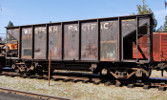
| Builder | Pullman Company |
| Built | 1953 |
| Type | Ballast car "Selective Hopper" |
| Acquisition | Donated by Union Pacific |
View a mechanical drawing of WP 10649.
WP 10649 Hopper
WP 10649 is a ballast car and is known as a “Selective Hopper”. Ballast is the gravel or coarse stone used to form the bed of a railroad track. The term “selective” is applied to hoppers that can open either single or multiple gates to unload the ballast. This car was built in 1953 by the Pullman Company.
It is 36 feet long with an internal length of 30 feet 9 inches. The car could carry up to 1,663 cubic feet of ballast with a maximum load of 171,000 lbs.
WP 10649 was donated to the museum by Union Pacific Railroad in 1986.
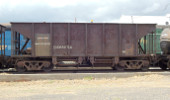
| Builder | American Car Foundry |
| Built | April-May 1957 |
| Type | HK selective hopper |
| Acquisition | Purchased by FRRS |
View a mechanical drawing of WP 10760.
WP 10760 Hopper
In 2001, Union Pacific had shoved ex-Western Pacific ballast car 10760 into the Jim Dobbas Inc. rail yard in Roseville for scrapping. The FRRS made special arrangements to purchase the car for $1000 from the scrapper.
Ballast Car 10760 was built by the American Car Foundry in April-May 1957. It is a class HK selective hopper type car with type B cast steel wheels in American Steel Foundry A-3 ride control trucks with Timken roller bearings. The term “selective” is applied to hoppers that can open either a single or multiple gates to unload the ballast.
The car is 32 feet 6 1/2 inches long with a maximum load limit of 140,000 lbs. Its internal volume is 1,694 cubic feet.
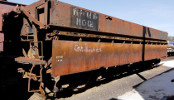
Western Pacific Maintenance-of-Way 11012 Gondola
This car, WP 11012, from the WP series 11001-11040 was built in 1927 by Western Wheeled Scraper Co. for Six Companies, Inc, and used for the building of Hoover Dam. WP bought their 40 cars from Six Companies after the dam was completed.
Cars of this type were used by the WP to haul rock and ballast in Maintenance-of-Way service. Originally painted black with large white Western Pacific on the sides they ended up being painted yellow.
They were used by the WP right up to the Union Pacific takeover. They were changed very little during service, and 11012 is a good representative of this class of car.
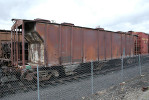
| Builder | Pullman Standard |
| Built | February 1958 |
| Type | PS-2 |
| Operating weight | 60,900 lbs. (empty) |
| Acquisition | Donated by Union Pacific in 1984 |
The WP 11509 is a hopper car that is a good example of the first type of covered hopper cars used by the railroad, a lot different to the styles we see today. Western Pacific covered hopper car 11509, series 11501-11510, was built by Pullman Standard in February 1958. This old gray car was the first type of large capacity covered hopper owned by WP.
It is a 50 foot, 3 bay steel PS-2 type covered hopper that was used for potash and phosphate service. It has a capacity of 2,893 cubic feet and a maximum load of 140,000 lbs.
It was donated by Union Pacific in 1984.
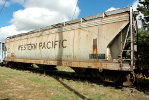
| Builder | American Car Foundry |
| Built | 1975 |
| Type | Covered Center Flow Hopper |
| Acquisition | Donated by members of the "Western Pacific" Yahoo Group |
WP 11974 is a center flow hopper and is one of the later ones with the billboard WESTERN PACIFIC on the side. Built in 1975 by American Car Foundry, it is a 4,600 cubic foot capacity, three-compartment car with six individual loading 30” hatches on top. It has a load capacity of 198,000 lbs.
Union Pacific retired the car and sent it to Jim Dobbas Inc. near Sacramento, presumably for scrapping. This car was purchased by members of the "Western Pacific" Yahoo Group and donated to the museum in 2002.
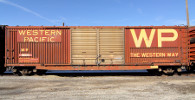
Western Pacific 19901 Transco 50' double door boxcar
From the 1950s until the mid 70s, the WP was at the forefront of exploring special freight equipment for their shippers. In 1964-65, one such experiment saw the road acquiring a small fleet of 40 and 50 foot long boxcars. Rebuilt by Transco Products from second hand cars, they featured an unusual ribbed body made of Tri-Rib nailable steel.
The Rio Grande and Santa Fe, among others, also tested similar cars. Unfortunately, the Tri-Rib material, which featured tight grooves on the interior to hold fasteners, did not last well in service.
WP 19901 build in September 1965 is one of the few survivors from this experiment in lightweight boxcars. It was donated by Reno BSA.
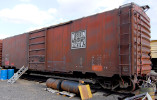
| Builder | Pullman-Standard |
| Built | June 1955 |
| Type | PS-1 XM Boxcar |
| Volume | 4844 cubic ft |
| Capacity | 50-tons |
| Operational Weight | 52,000 lbs |
| Interior Length | 50 ft 5-9⁄16 in |
| Interior Width | 9 ft 2-1⁄16 in |
| Interior Height | 10 ft 5-1⁄2 in |
| Length Over Strikers | 51 ft 10 in |
| Overall Width | 10 ft 5-1⁄16 in |
| Overall Height | 14 ft 11-15⁄16 in |
| Clear Door Opening | 8 ft 0 in wide X 9 ft 10-5⁄16 in high |
| Door Type | Superior 6-panel sliding |
| Trucks | Scullin A-3 Ride Control |
Western Pacific 36011 – XM-class PS-1 Boxcar
WP 36011 was part of a Western Pacific order delivered in June 1955 numbered 36001-36025.
The cars were XM-class PS-1s built by Pullman-Standard. They featured 8-foot Superior 6-panel doors, welded sides and Scullin A-3 Ride Control plain bearing trucks. They were uninsulated boxcars and were used for general merchandise. They had a capacity of 50-tons.
36011 was donated to the society by the Reno BSA.

The Western Pacific Railroad Museum in Portola is operated by the Feather River Rail Society. The FRRS is wholly funded by admissions, locomotive rentals, museum store sales, and generous donations of time, material, labor and money, and does not receive funding from any local, federal or state governments. The volunteers of the FRRS restore equipment, operate trains, sort and catalog archives, repair and improve the facilities, and perform hundreds of "house keeping" type duties related to keeping the museum open.
In addition to the museum grounds and equipment, the society is the custodian of several notable archive collections, including historic photographs, equipment diagrams, business ledgers and authorizations for expenditure, equipment records and other important documentation from the Western Pacific Railroad.
On behalf of the members of the Feather River Rail Society, we invite you to join us in preserving the Western Pacific Railroad for current and future generations to enjoy.